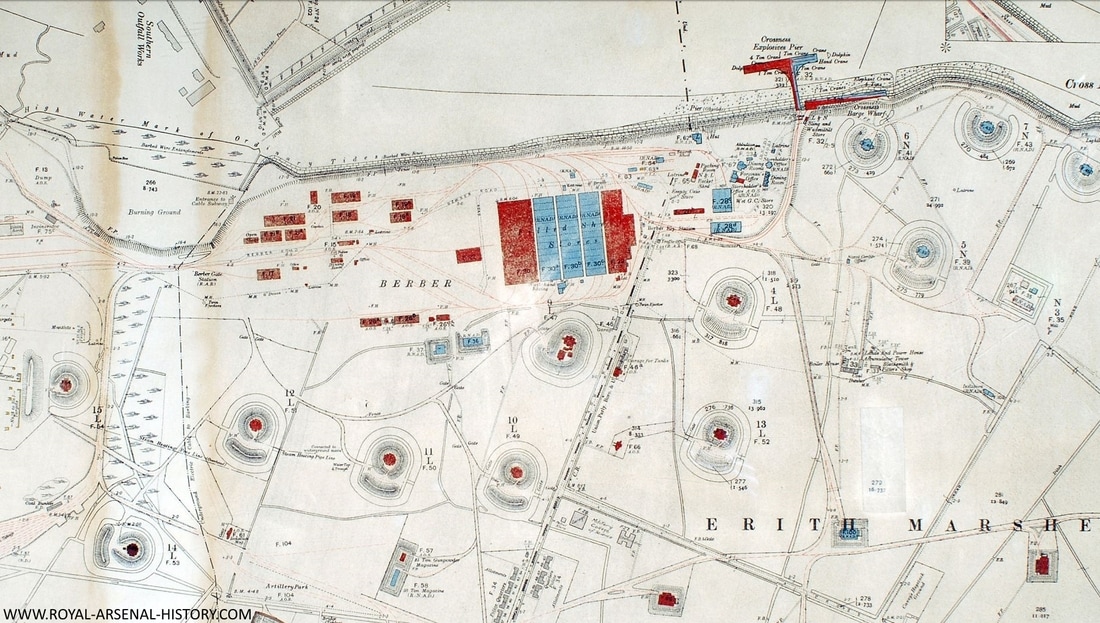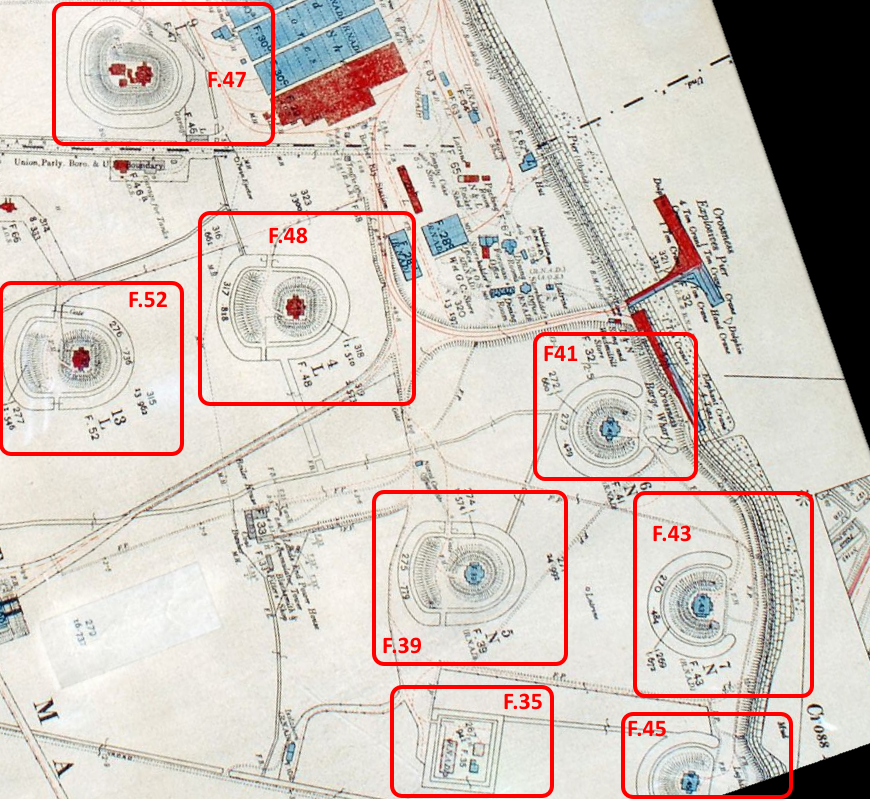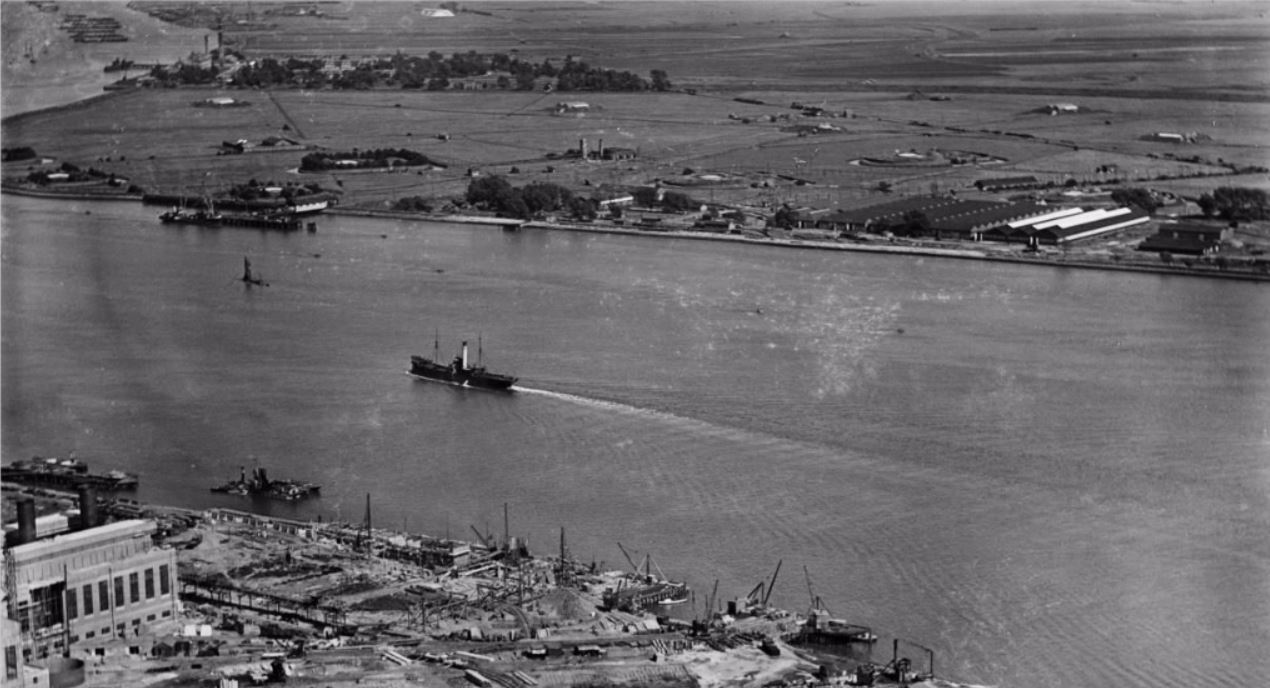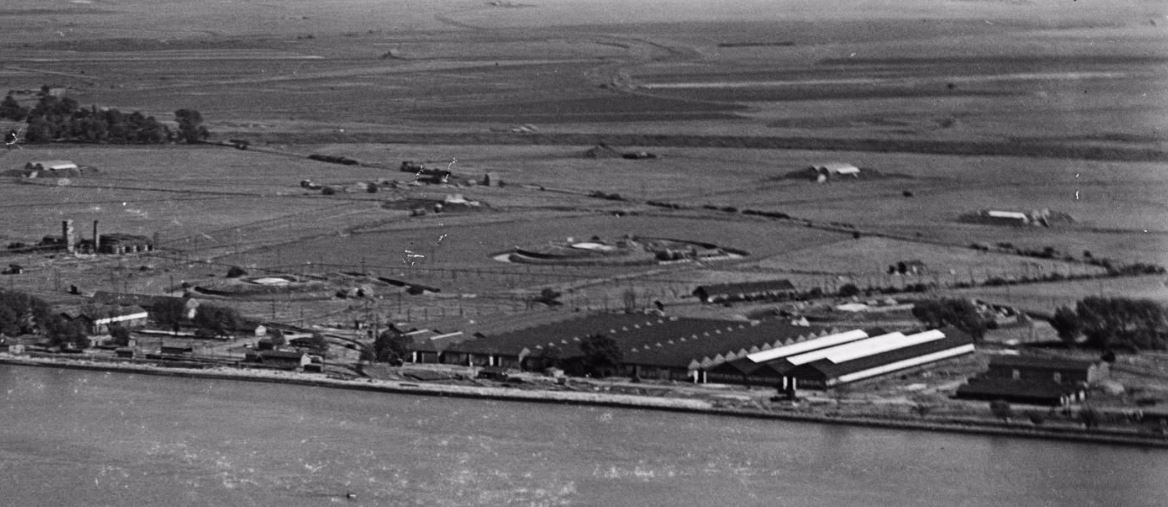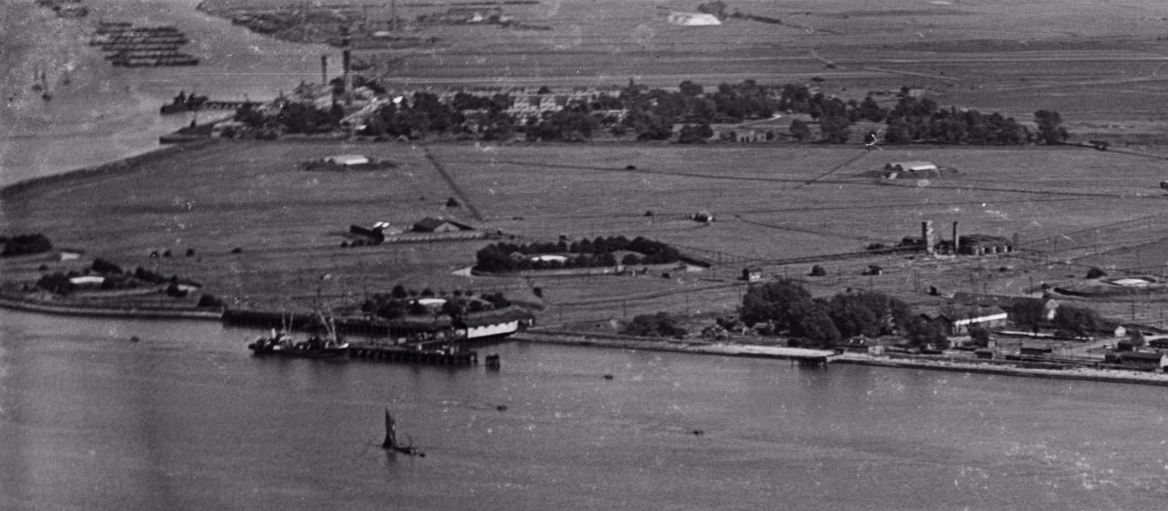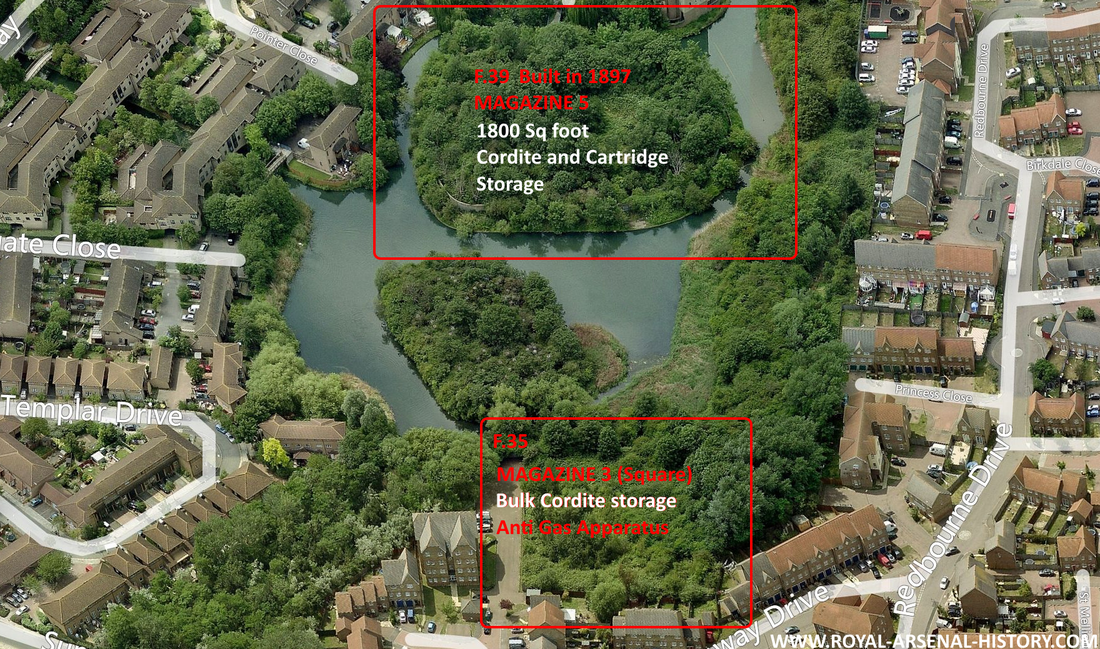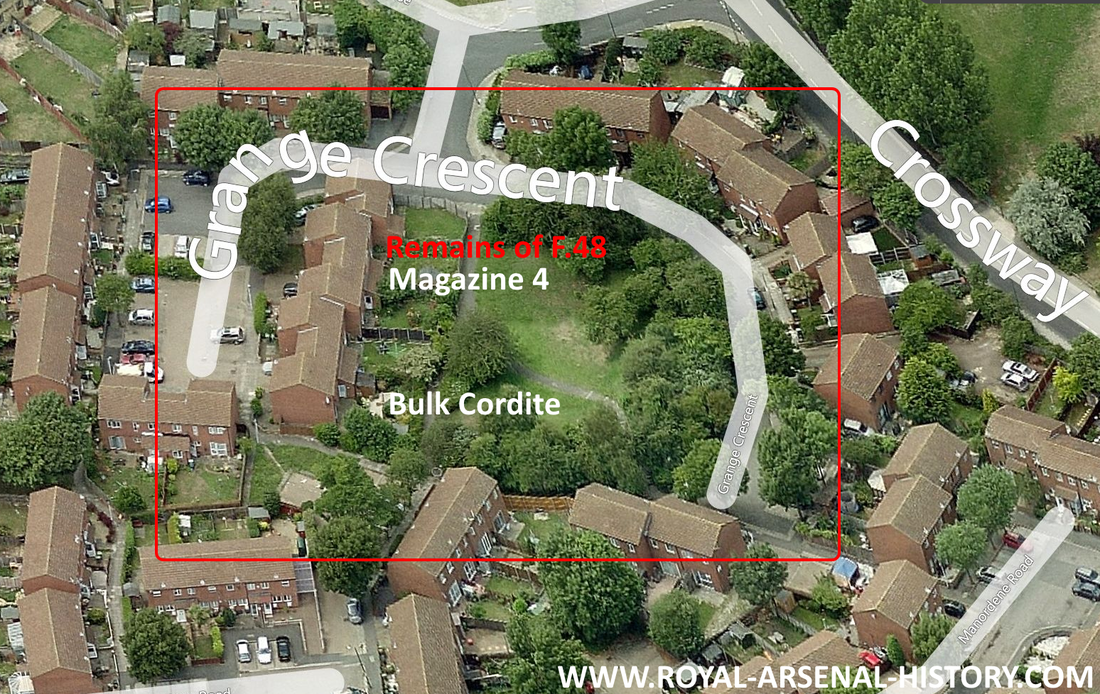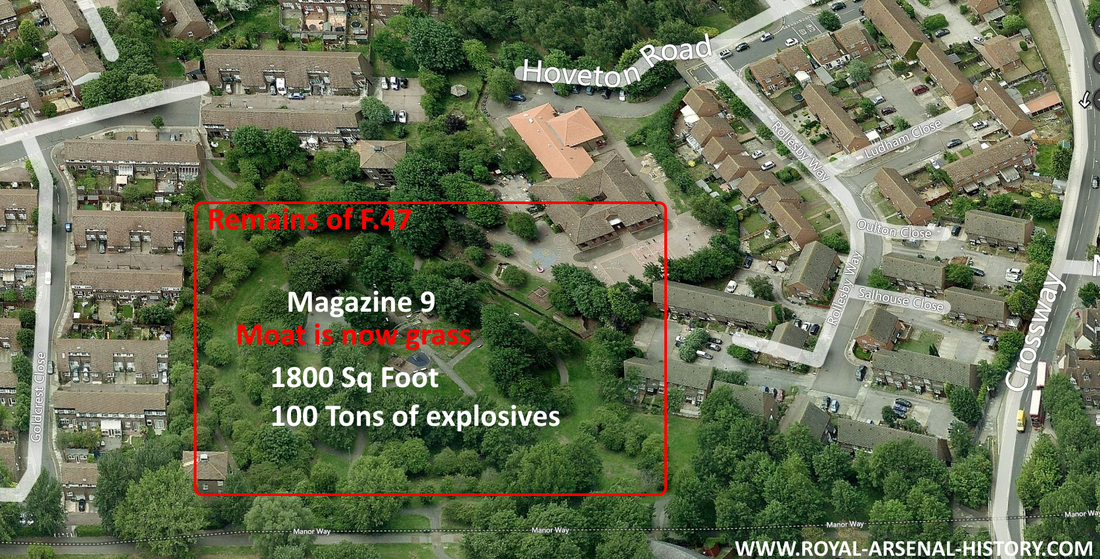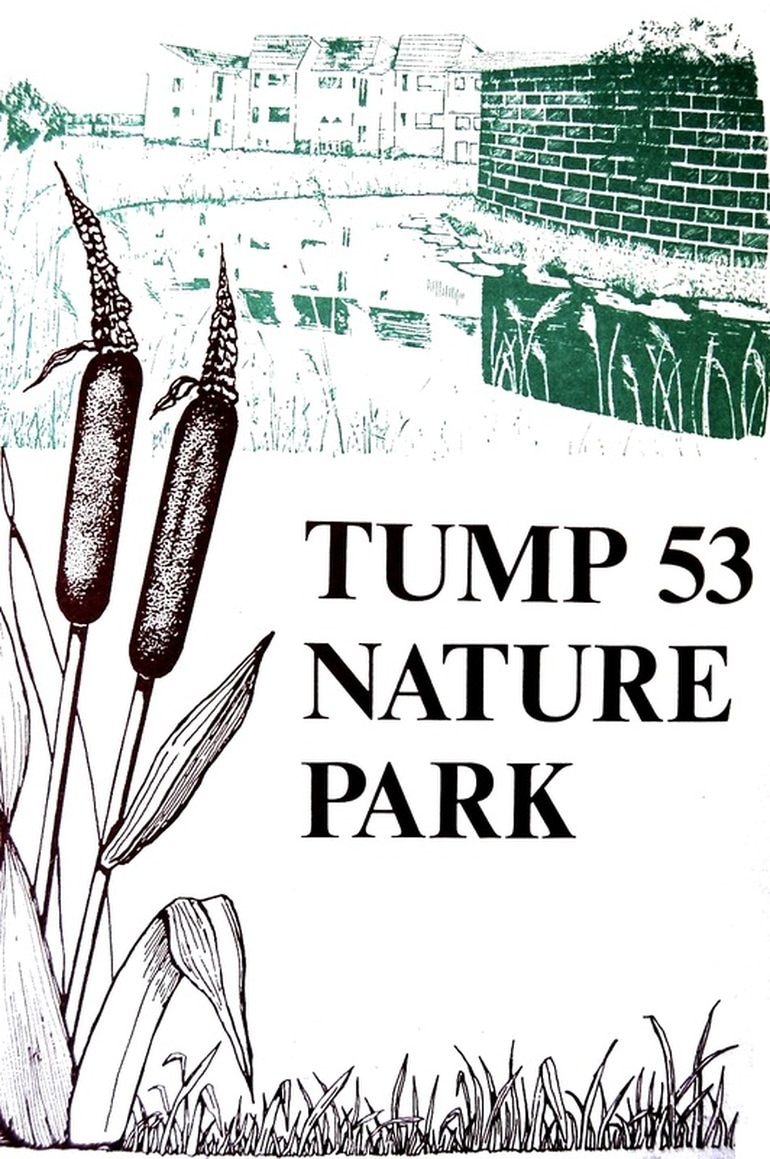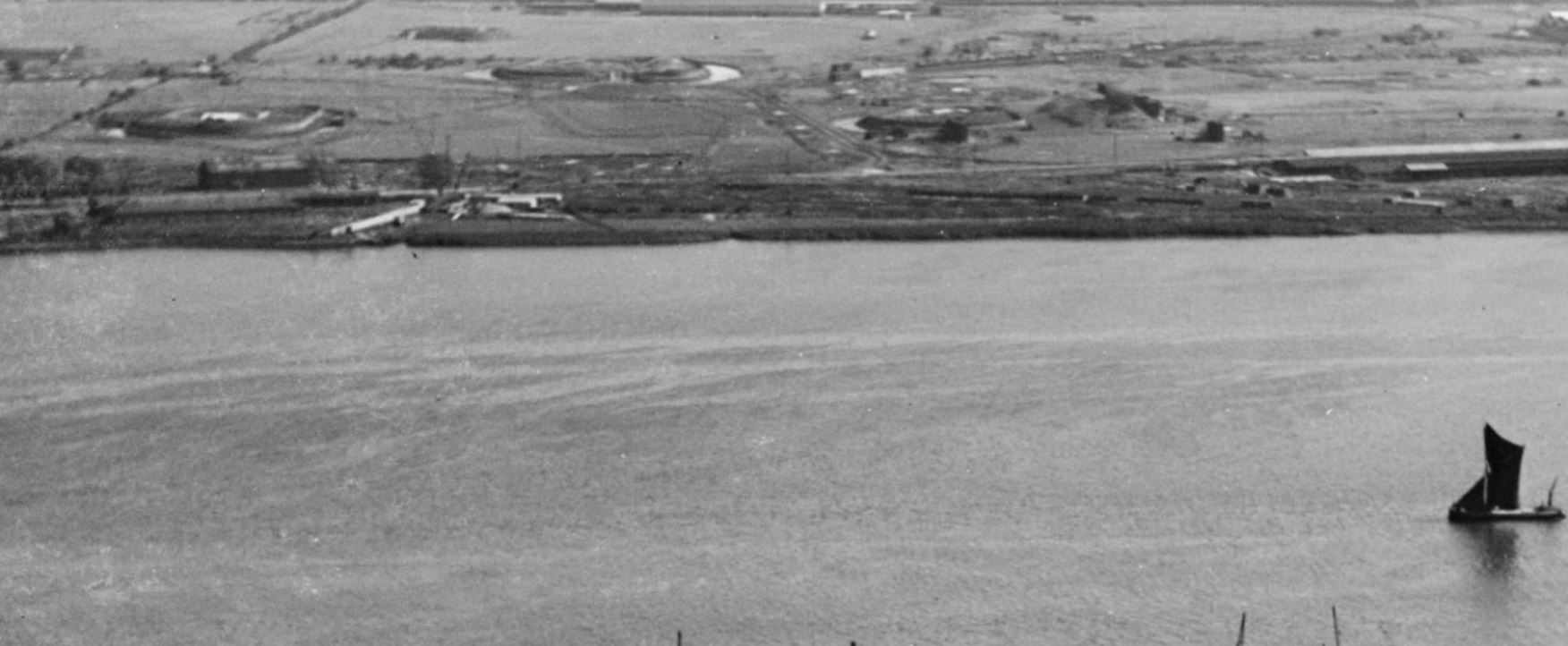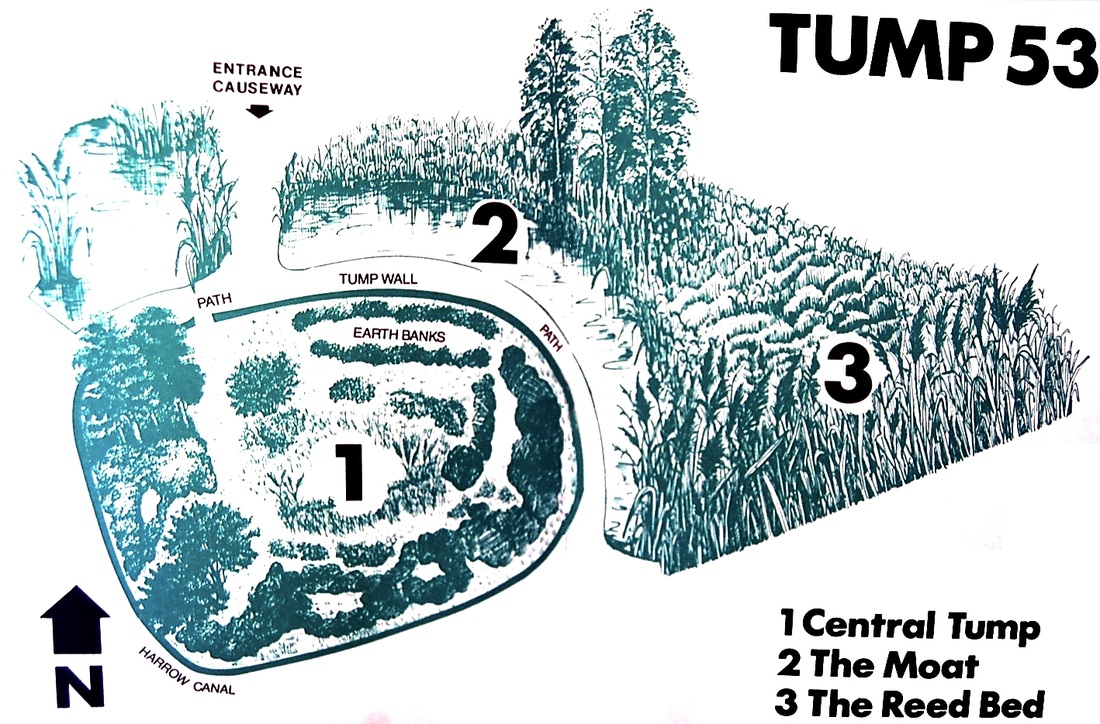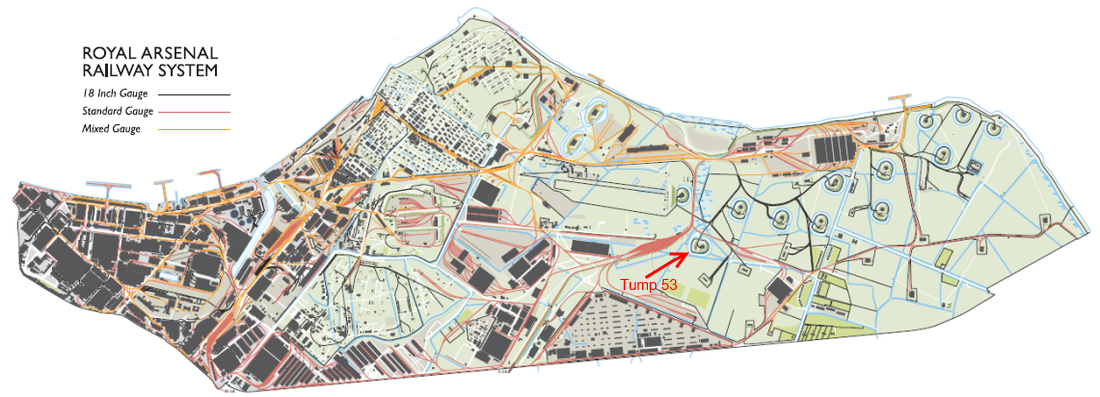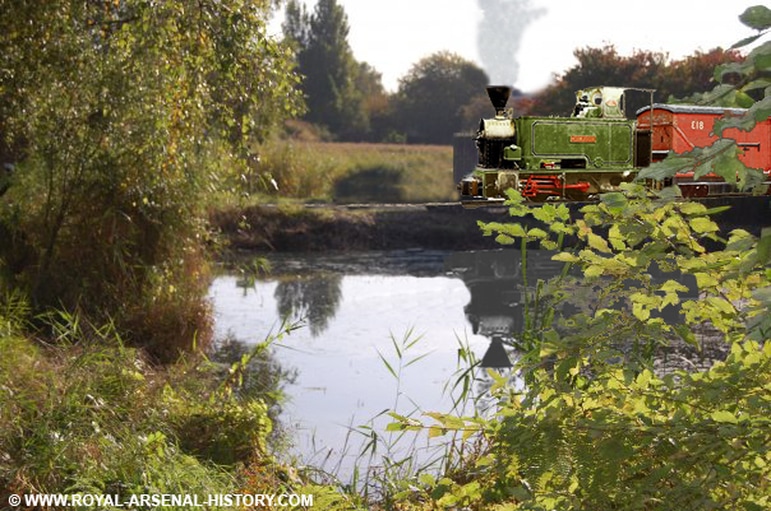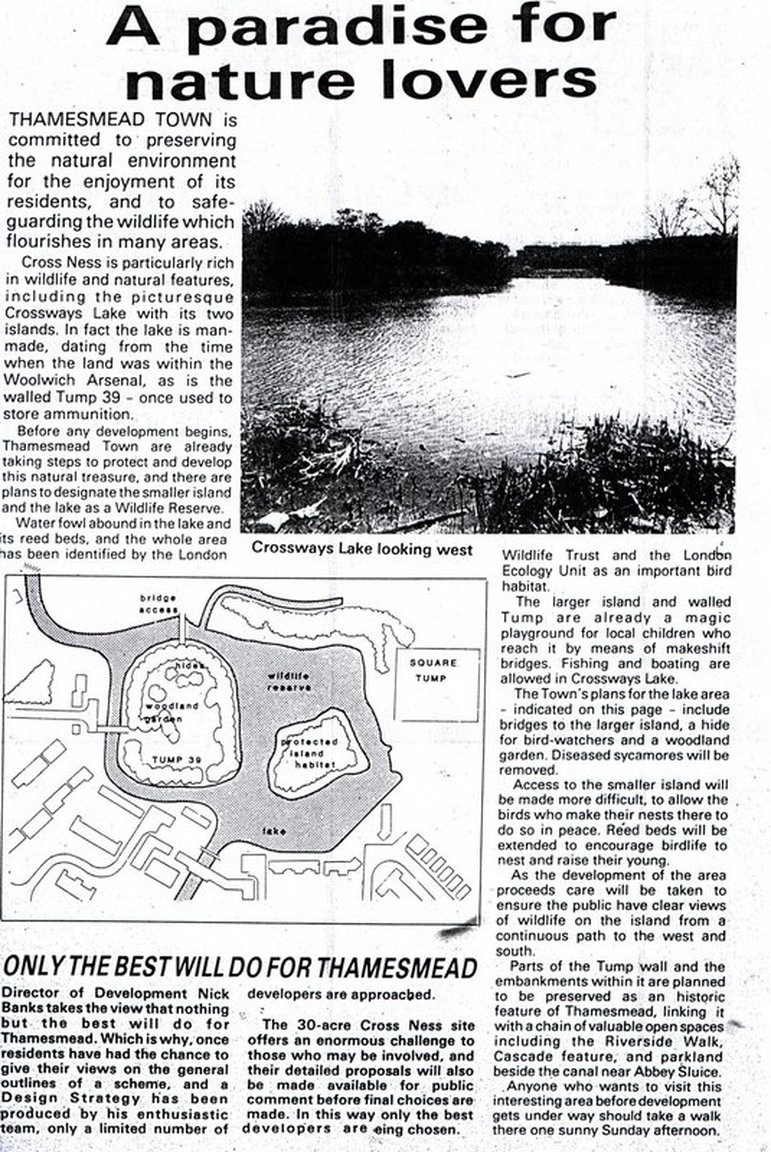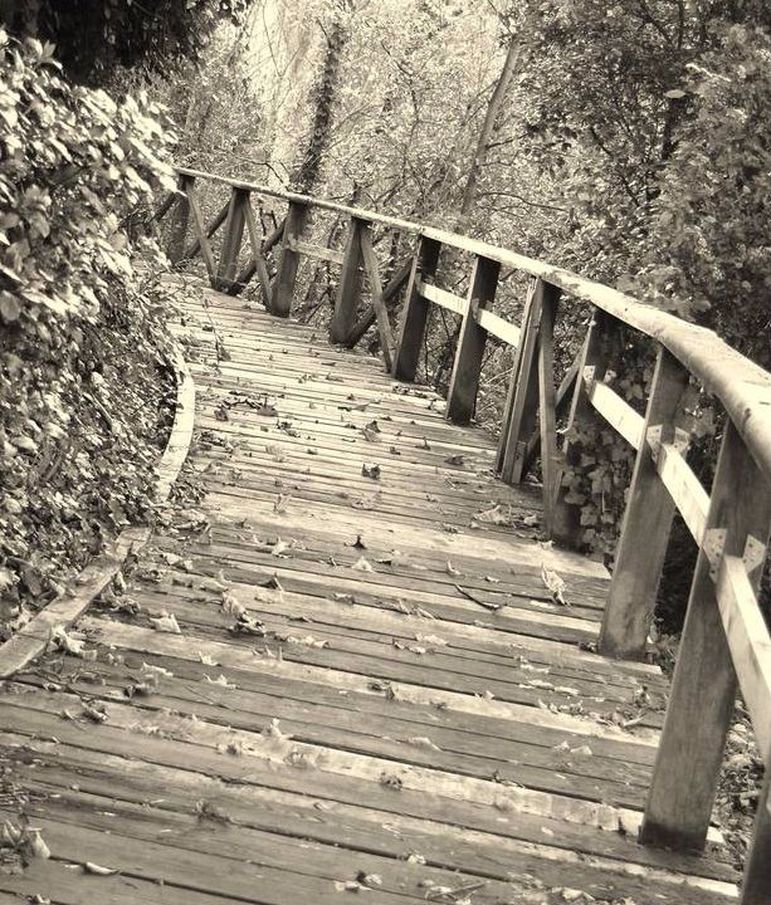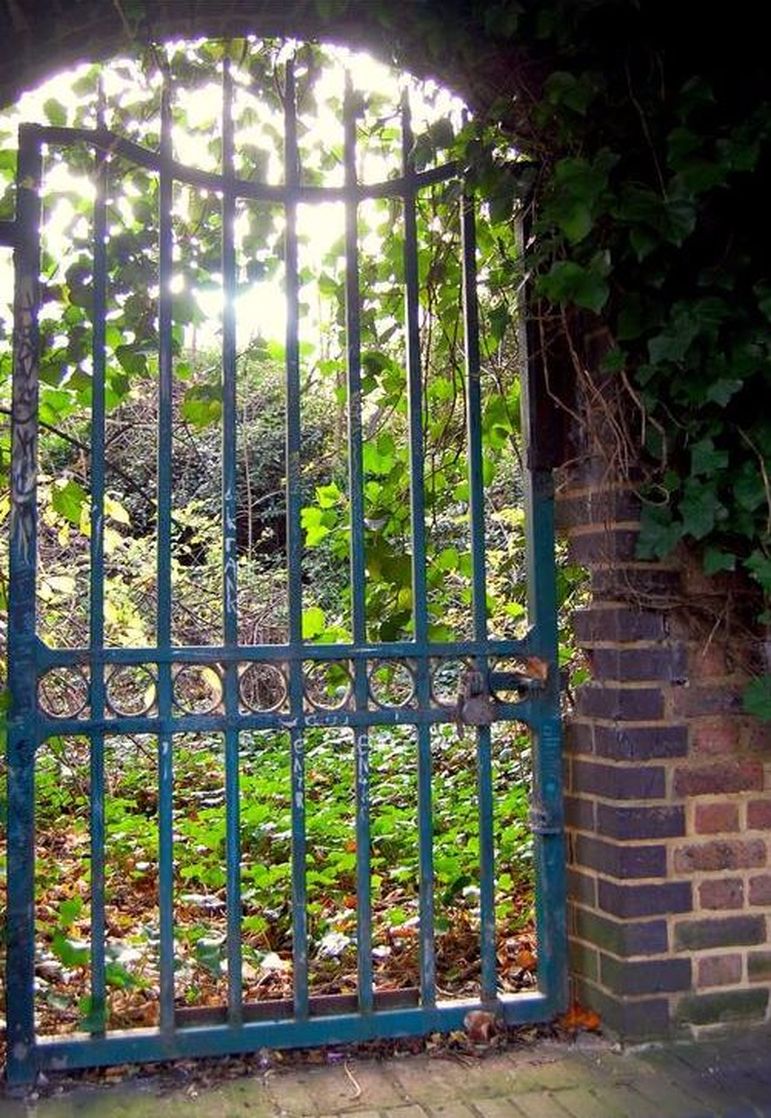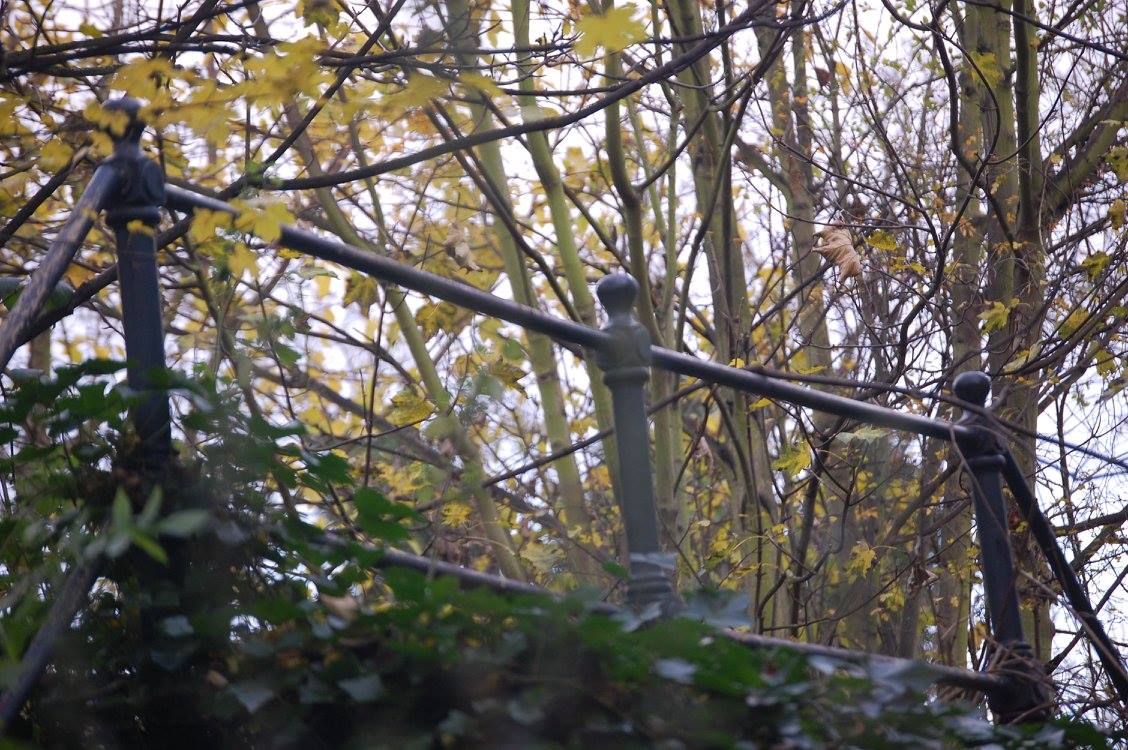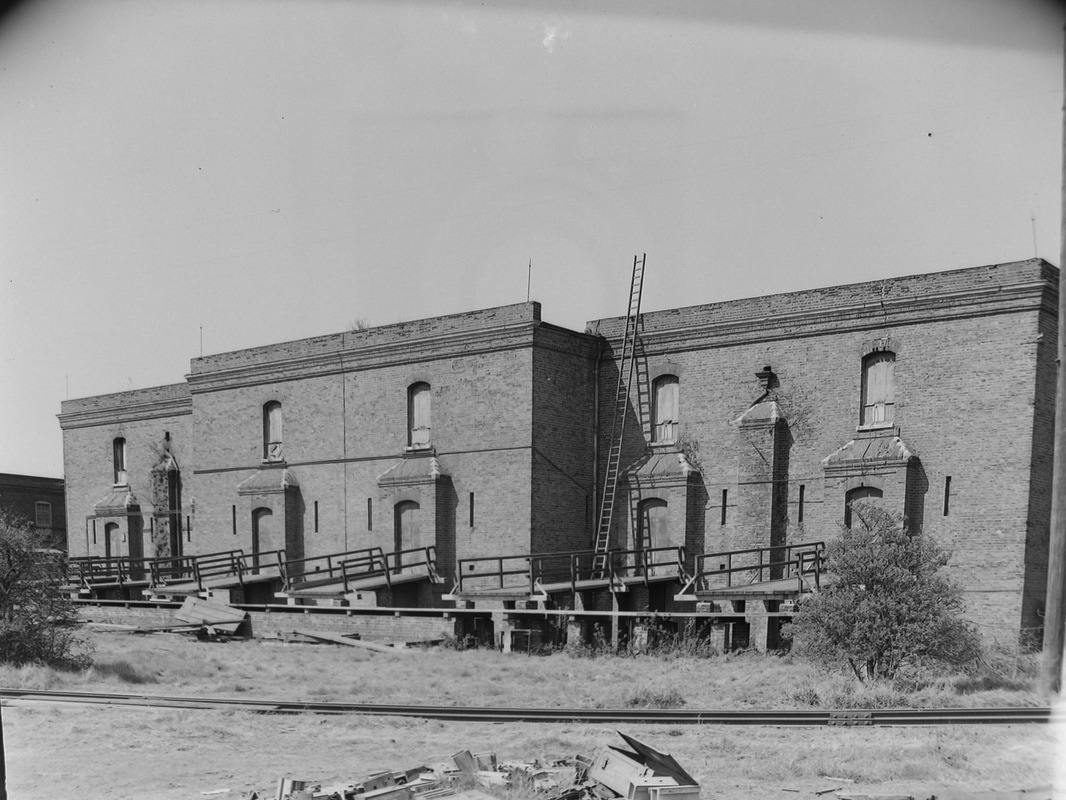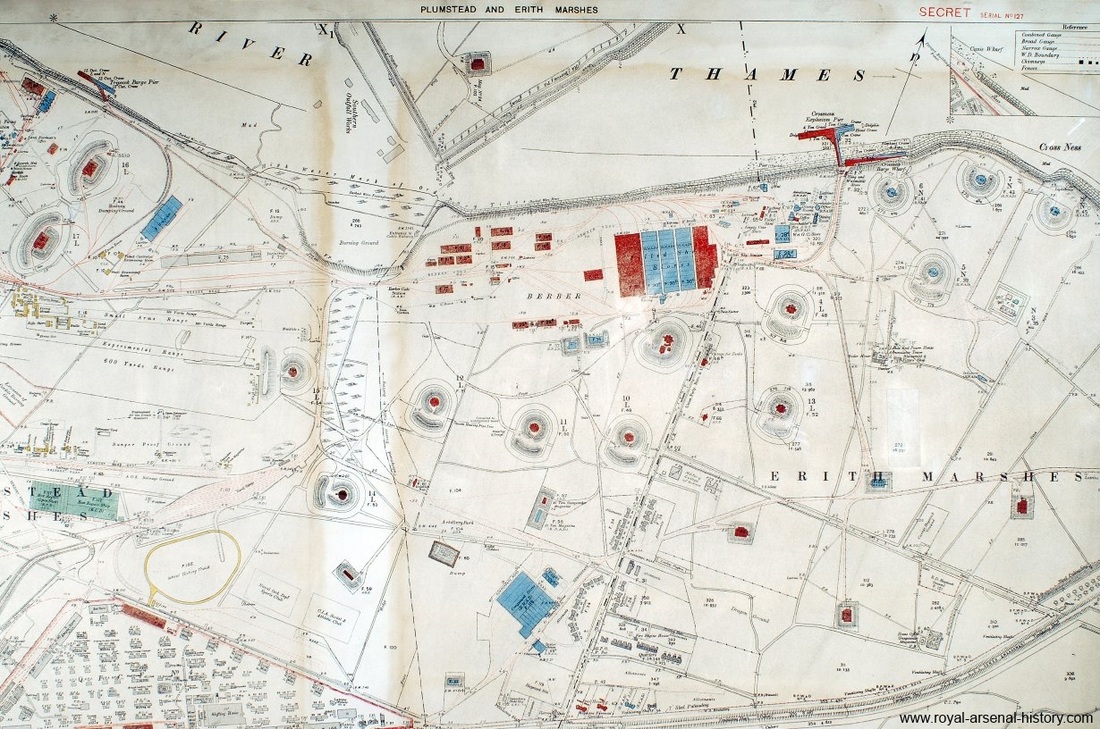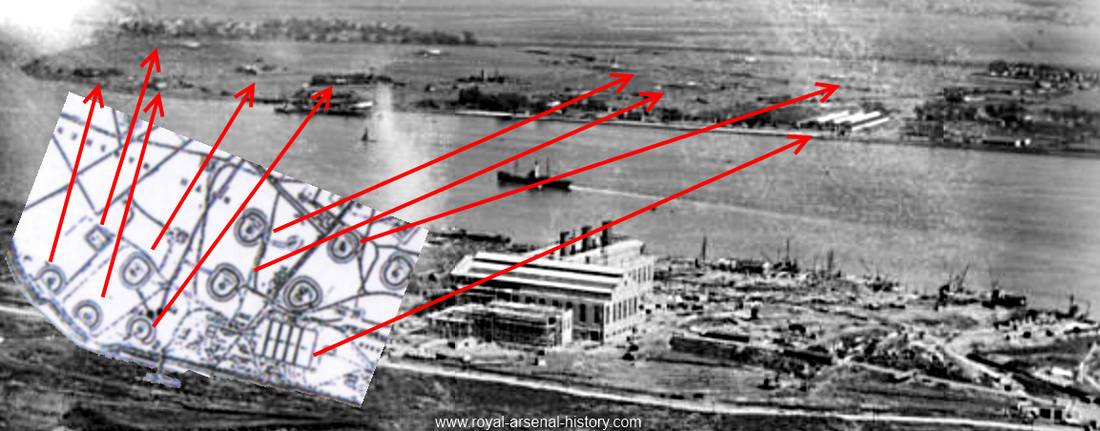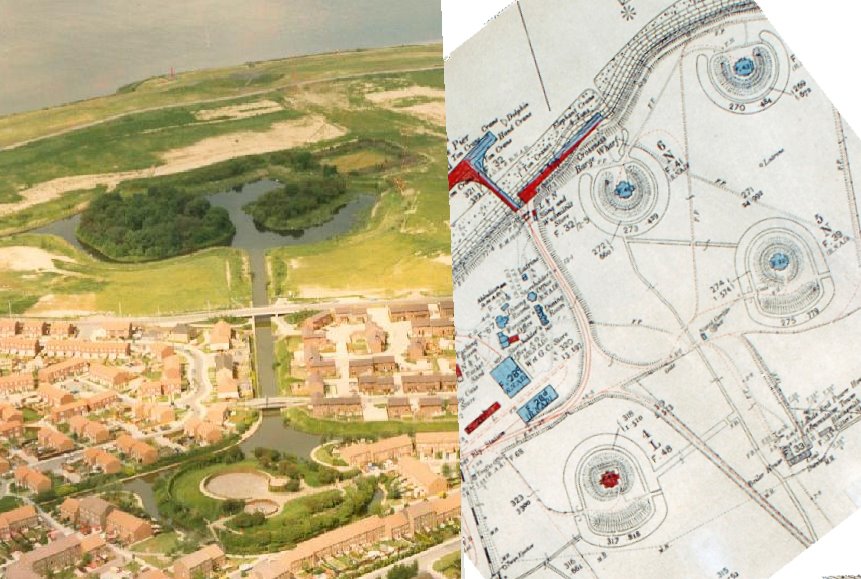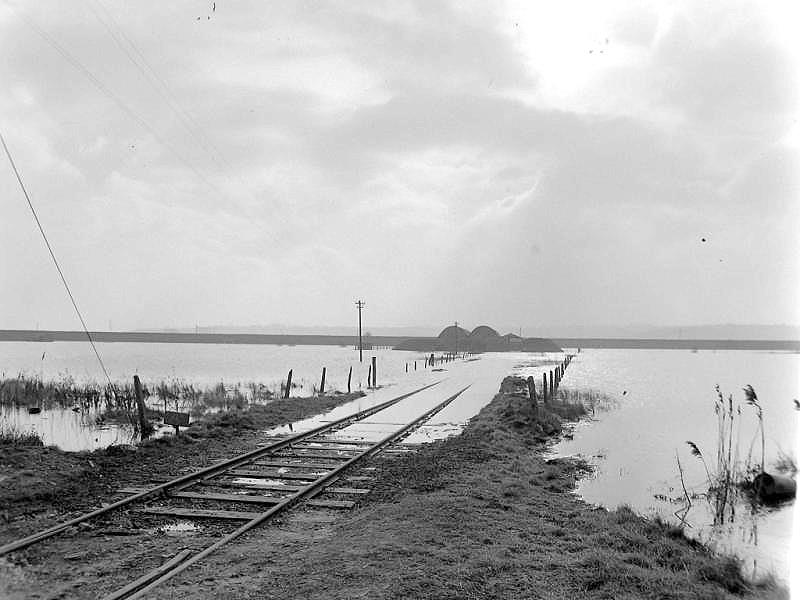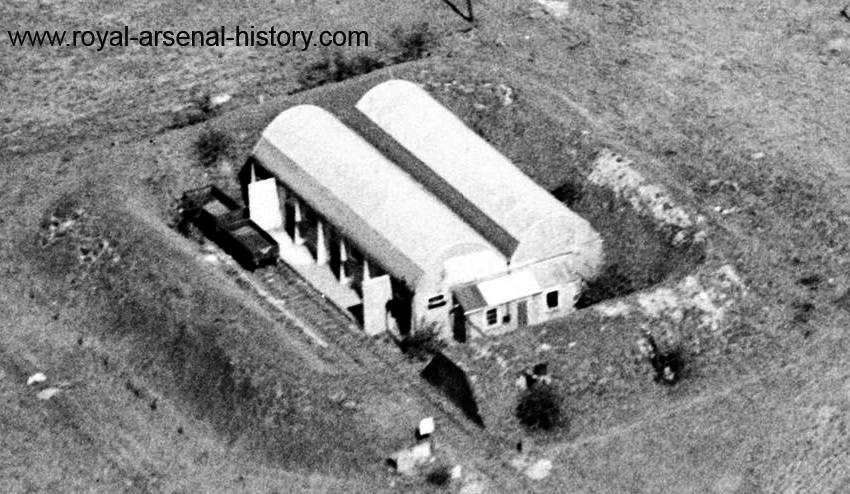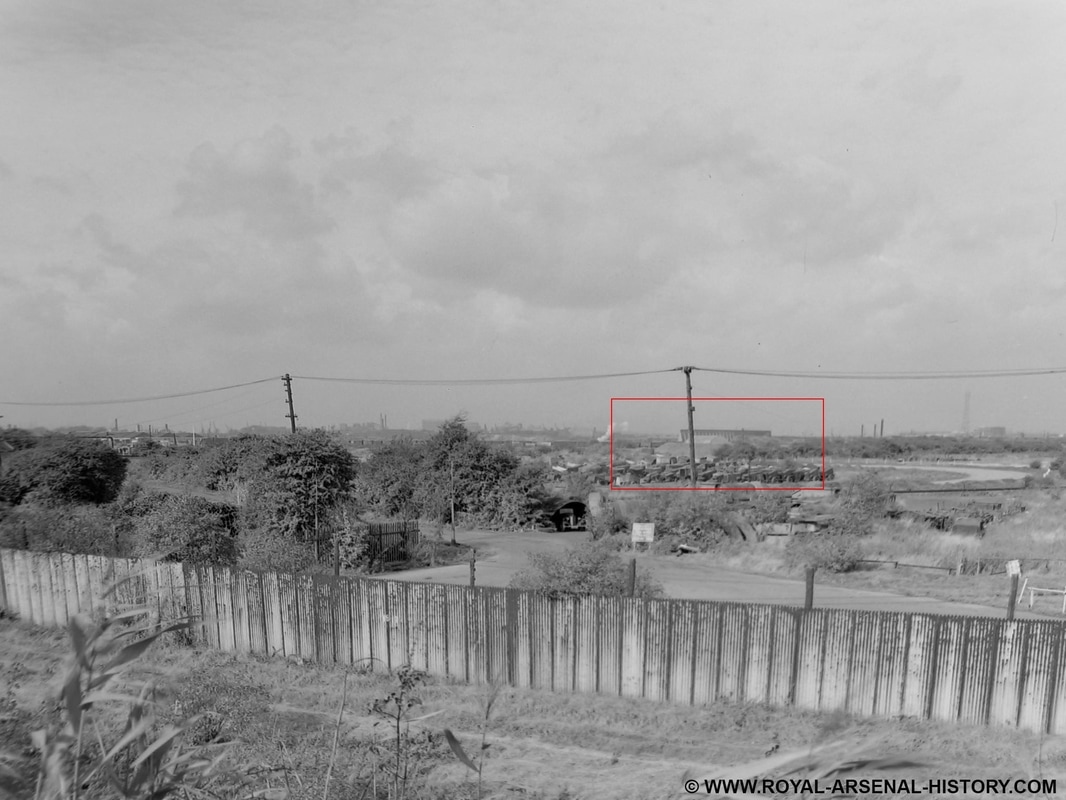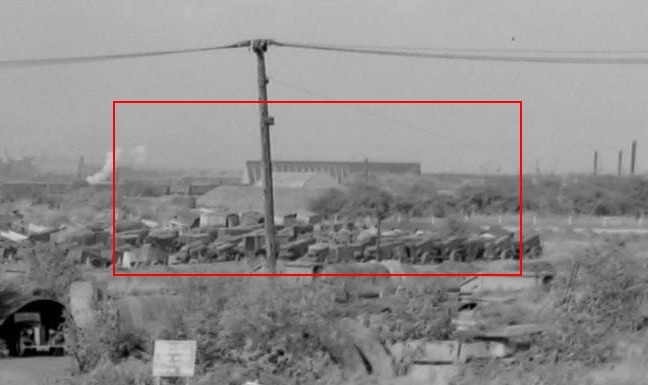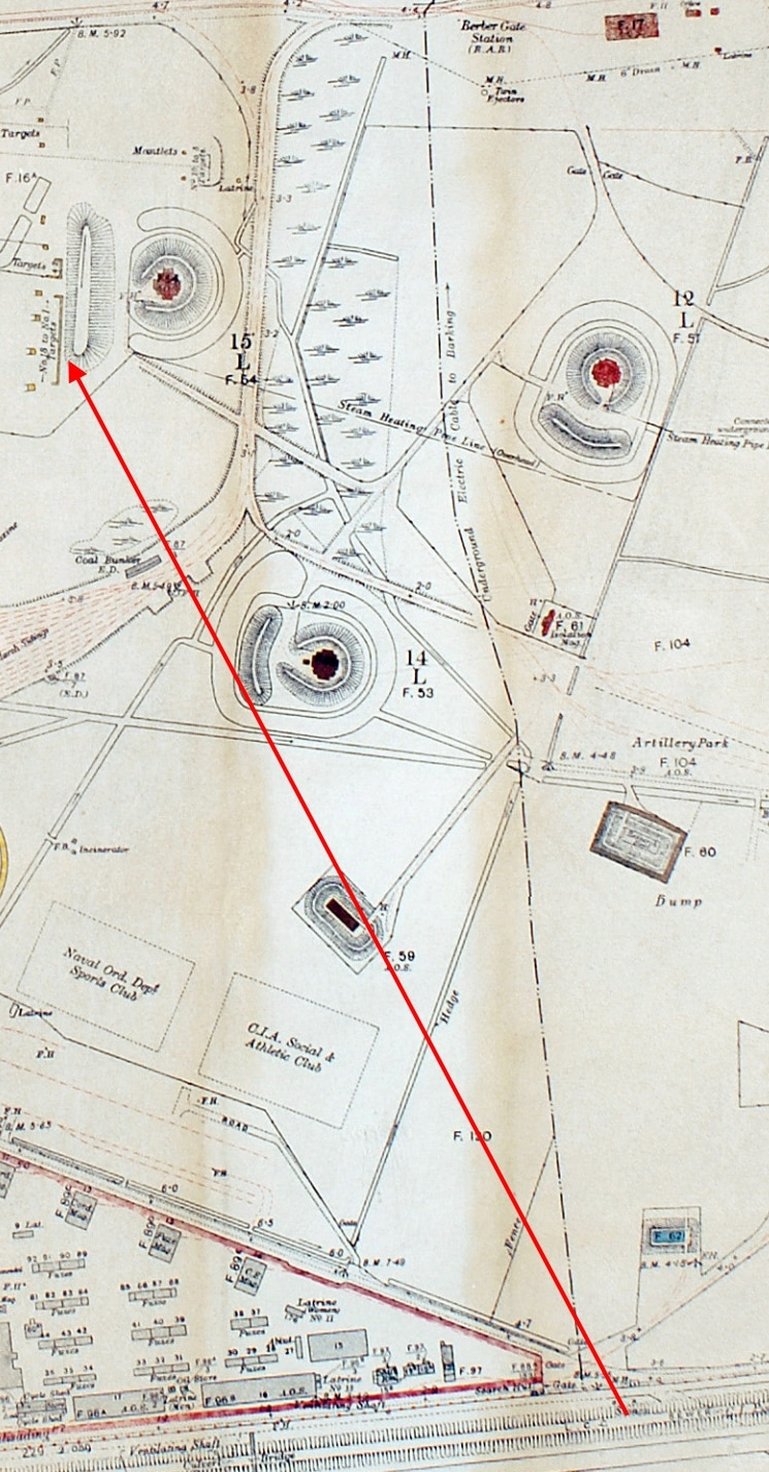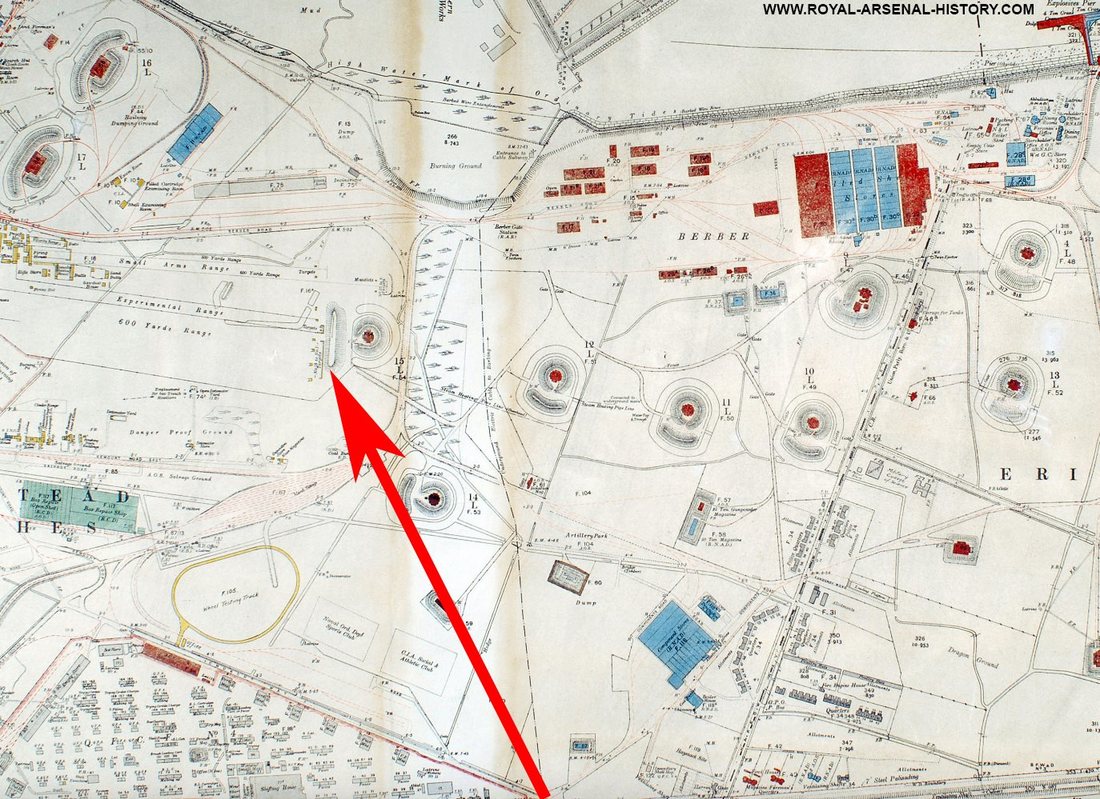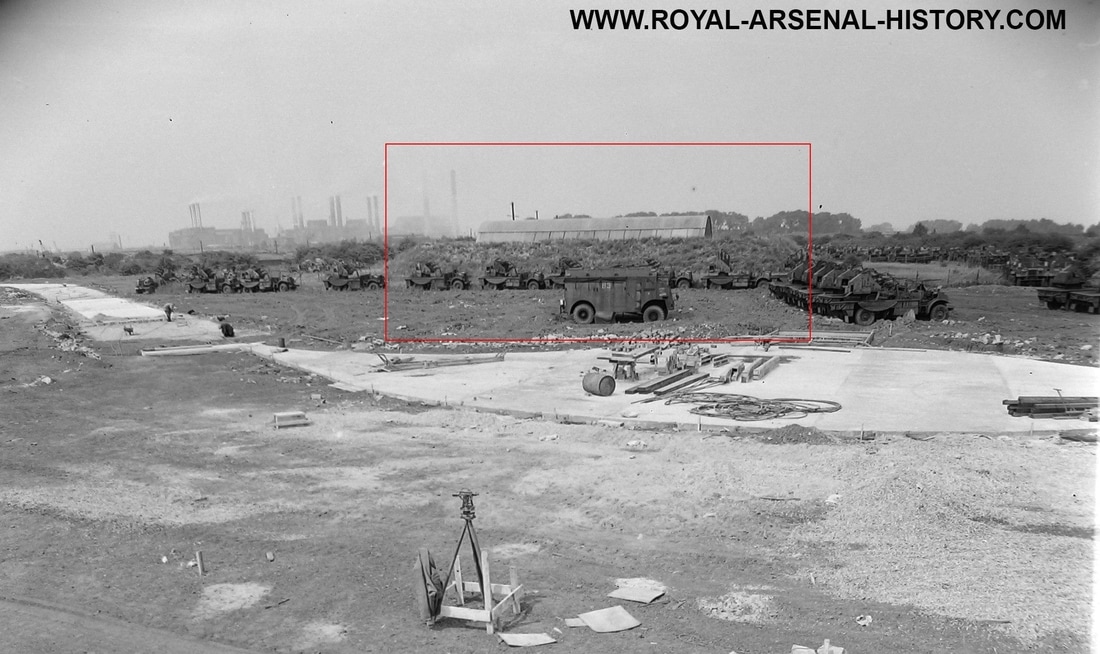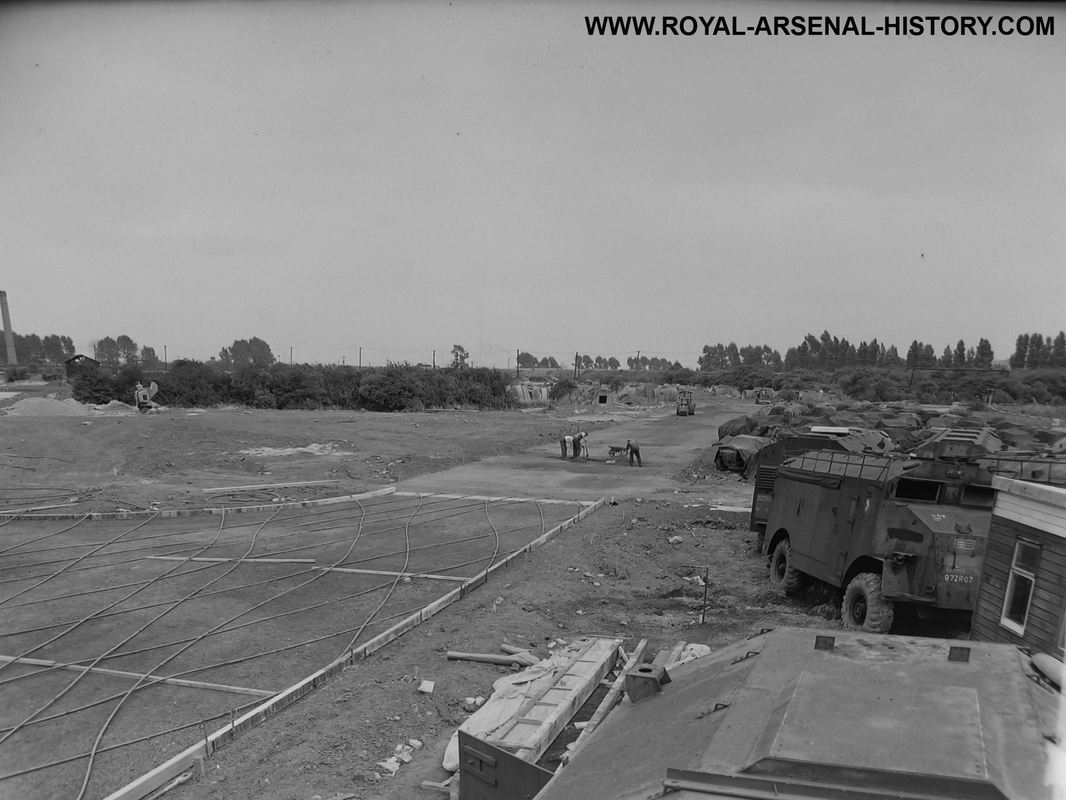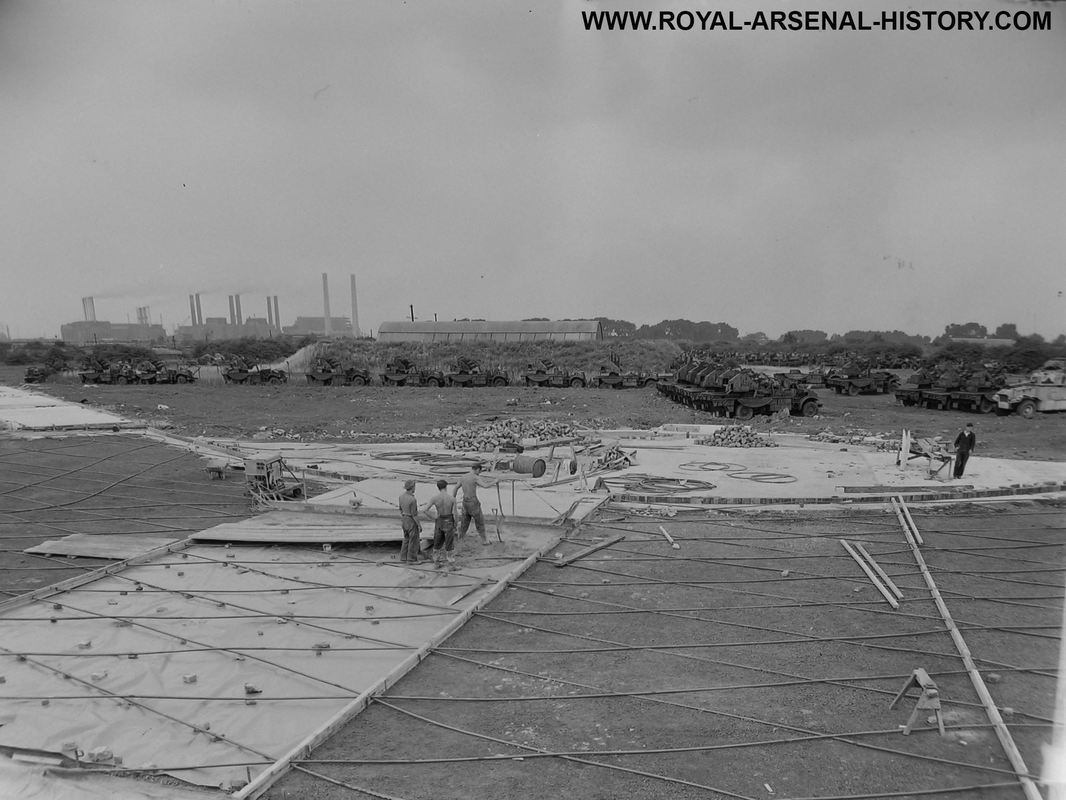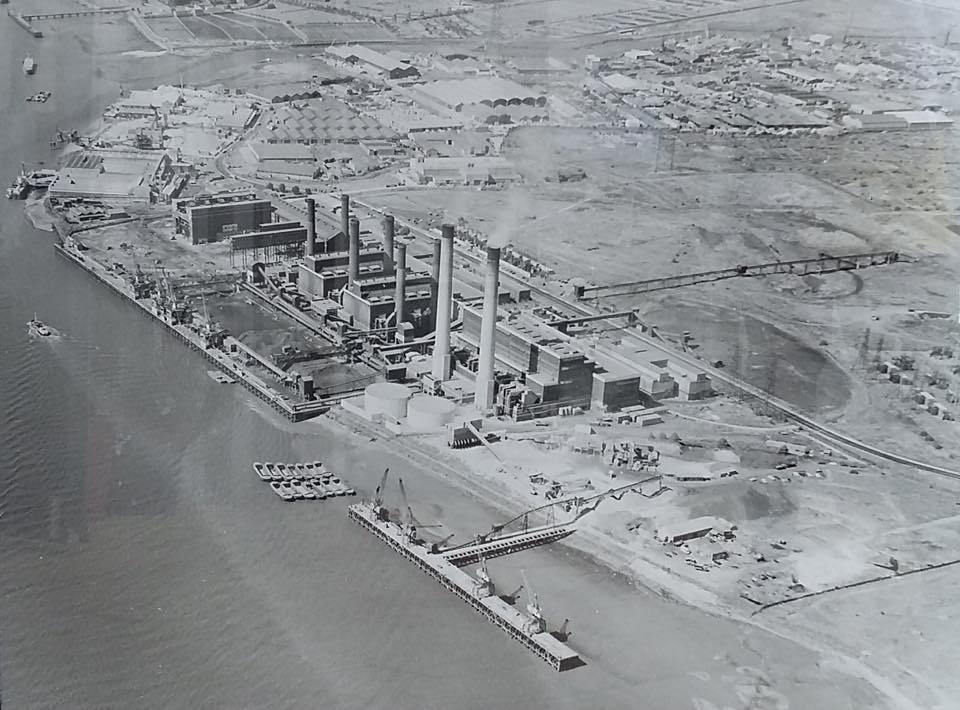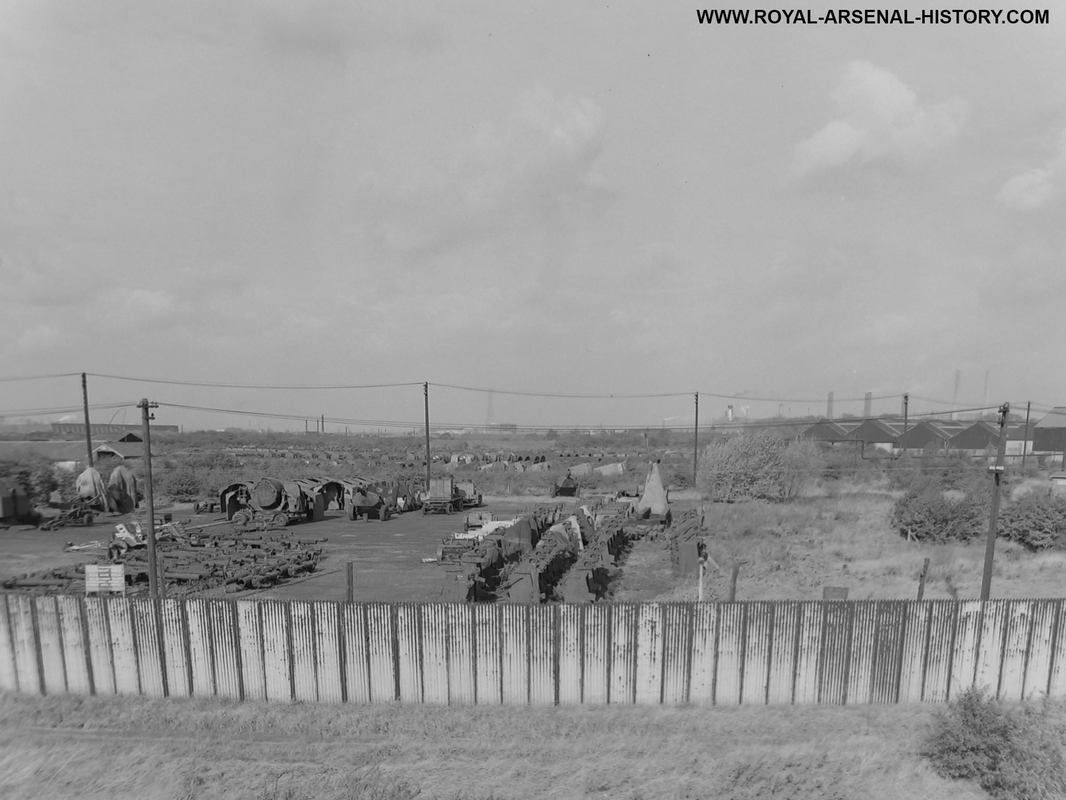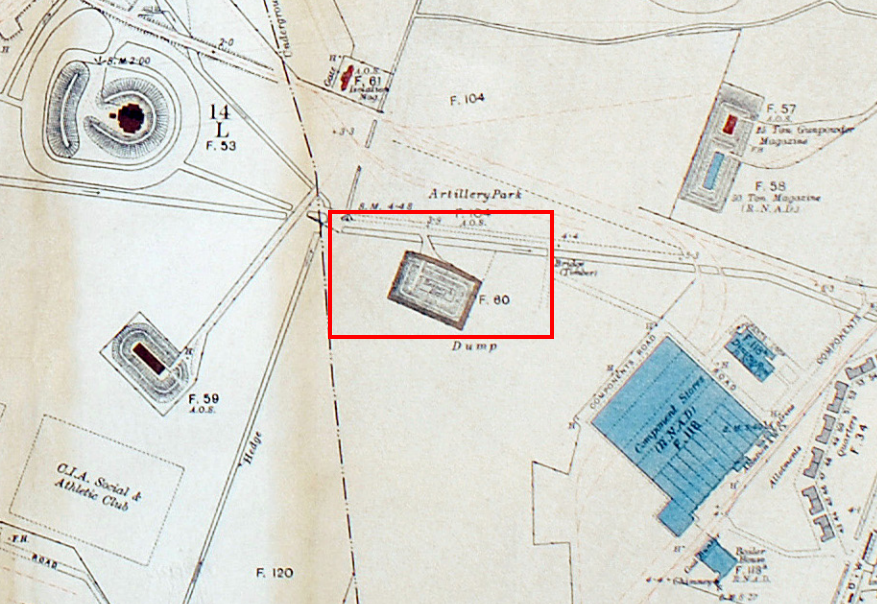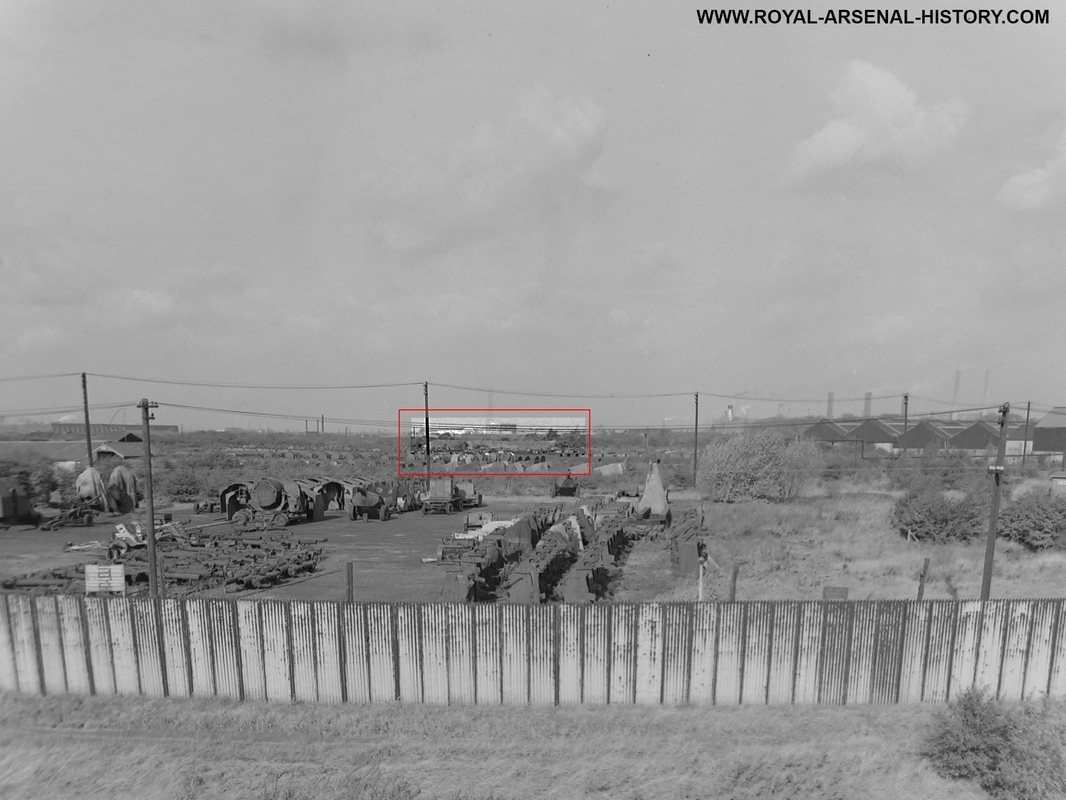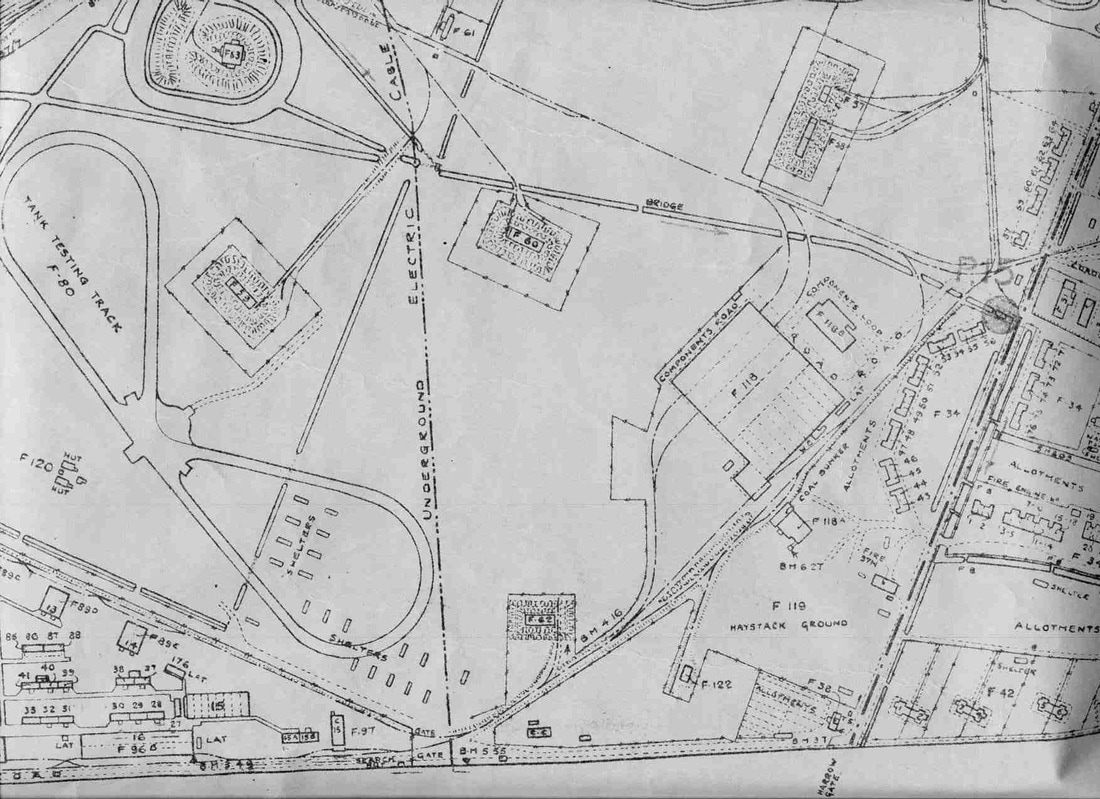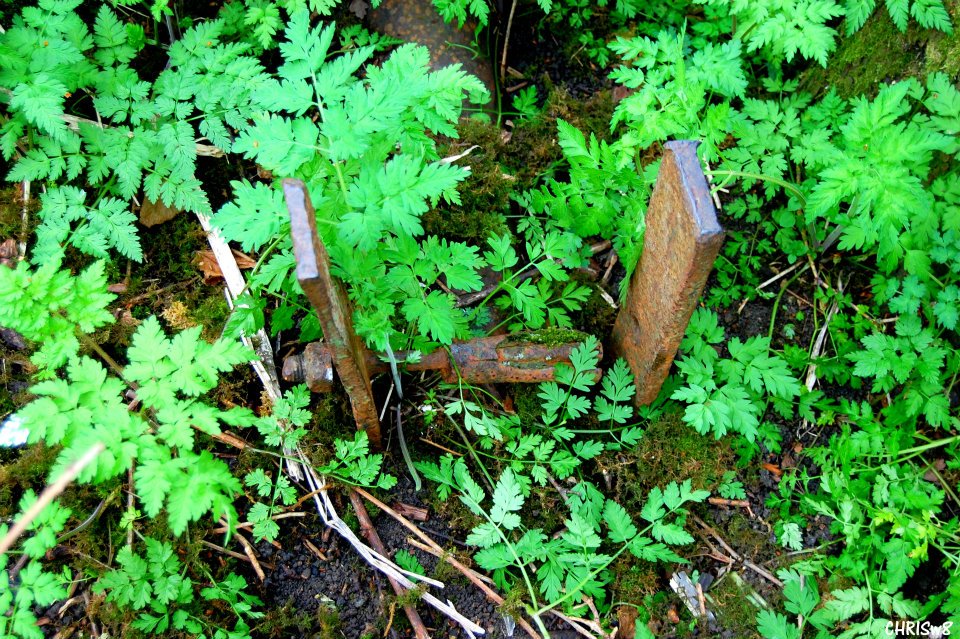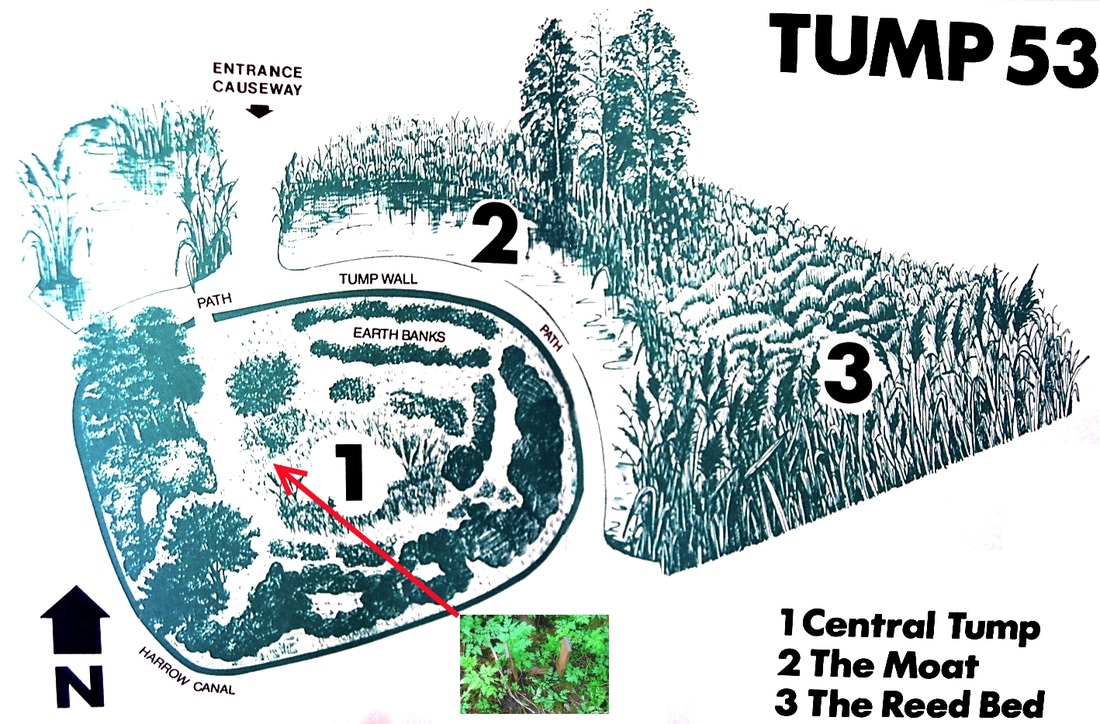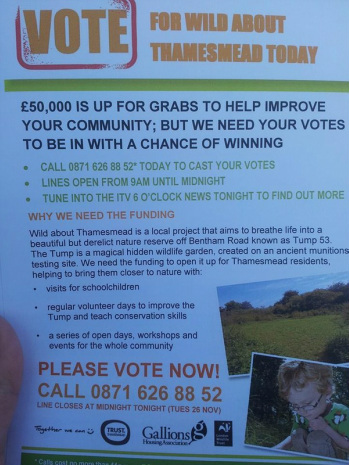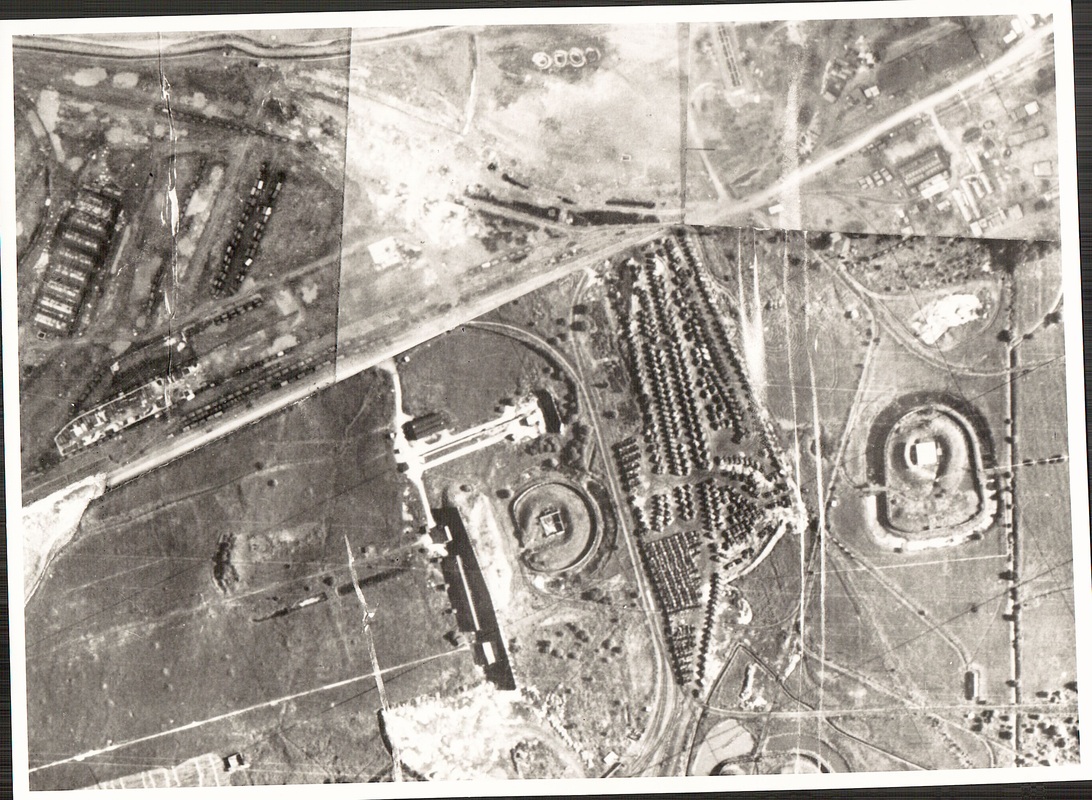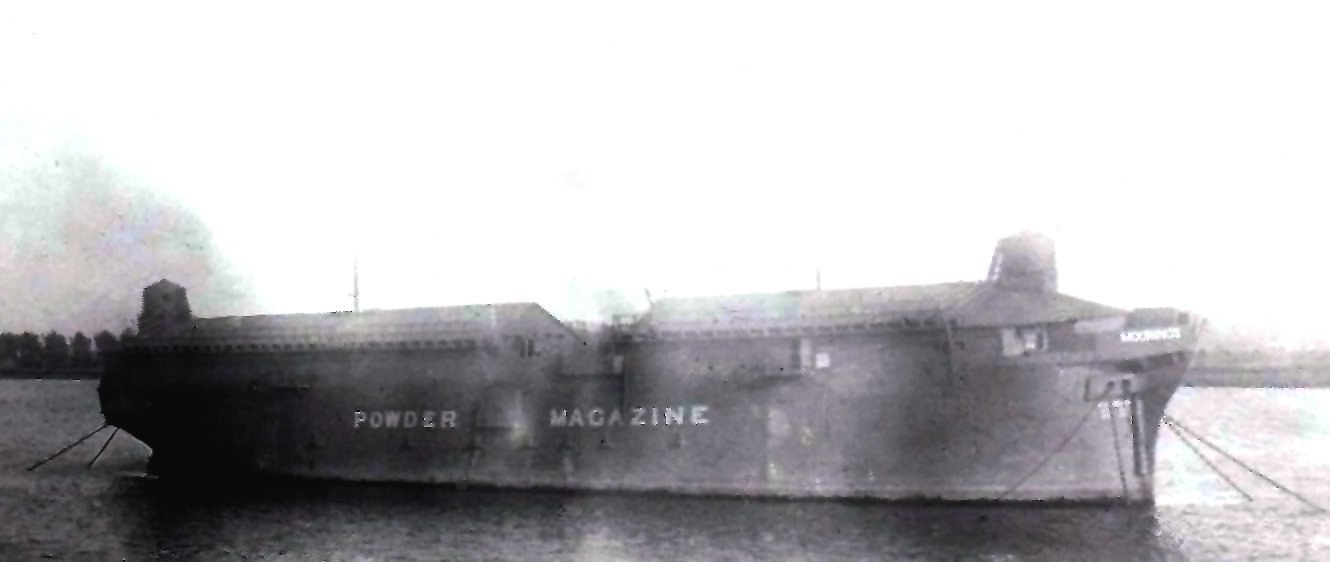What are Magazines? (Tumps)
The storage facilities were built at a time when Woolwich was considered to be a safe and secure location in 1897 confirmed in Hogg.
An Army Ammunition Depots Committee was set up in 1920 to consider the post war requirements for army ammunition storage facilities (Thamesmead/Plumstead Marshes). During WW1 we did not have sufficient storage space and depots for the amount of ammunition the Royal Arsenal ended up manufacturing for the war.
Not much notice was taken of this report and things just continued as they had through WW2. By the early 1950s 40,000 tons of ammunition were still stored, that was one of the main reasons for getting rid of the Eastern end, ceasing all ammunition work and closing down the narrow gauge railway. It was all over by 1962 so it had taken 42 years for the recommendations to be carried out.
As you can see Thamesmead's history played a big part in both world wars.
The Zeppelin and Gotha bomber raids of World War One identified the vulnerability of Woolwich and the need to relocate such storage facilities to more remote sites. During the 1930s rearmament programme new ordnance factories and storage facilities were built on sites widely distributed across the British Isles. The Royal Arsenal magazines gradually became redundant but some found alternative uses.
At one time just after the first great war there were 40 thousand tonnes of explosives in the Arsenal, enough to flatten Greenwich, Woolwich, Belvedere, Erith, half of north Kent and it was very worrying.
From Napoleon times onward's this was growing and growing fighting wars needing more and more explosives so the Royal Arsenal decided to build magazines to put all these explosives in.
First of all exploives had moved east of the canel towards Plumestead marshes, Belvedere marshes, Erith Marshes so there were none in the manufacturing area at that period.
When they started building these magazines they made pits in the ground with concrete and brick half below the ground then they ploughed them up with earth to try to force an explosion upwards and then they had a moat all the way around.
In those days the summer holidays were 8 weeks of pure sunshine, the marshes presented a big fire hazard as the marshes became dry, dry grass, shrubs etc. to stop fires spreading if they did start they put moats all around them and connected to the next moat by 12 foot trenches. Most people assumed the moat was to stop the fire spreading outwards, however this was not the case it was to stop fire spreading inbound into the Magazine/Tump.
The moat canals were 5 km long and connected to each other.
Today there is 7.5 km of canal and 6 lakes in Thamesmead.
Below experience of Roy Masters as a boy rafting and skating the canals.
Browse audio between 09:00 - 12:07 minutes
BBC Radio 4 audio and Royal-Arsenal-History slide show overlay
1887 Landscape vs Todays Magazine Landscape - Thamesmead Stage 5
Moated Magazine no. 14 (F53) - Tump 53
Tump 53 was seeded with a mixture of grasses and flowering plants, for example: the creeping bent and red fescue grasses and the white (or dutch) clover, which is a familiar member of the pea family. Clover flowers offer bees the lure of a sugary nectar to drink, and in return, the bees pollinate the flowers. Much of the woodland is of hawthorn and elder, together with bramble, a sprawling climber. All three are well established British plants. Such native plants provide food and shelter for many insects and birds but have an inbuilt protection against larger animals. Hawthorn and bramble bear protective thorns, while elder has leaves poisonous to rabbits and browsing livestock. All produce berries. These, together with insects—such as hoverflies, true flies and beetles seeking out nectar— provide plunder for many birds. The densely growing shrubs also provide nesting places for the birds. Growing beneath and around the shrubs are plants which can tolerate being partially shaded by the leaves above The pinkish-white flowers of soapwort have petals which feel like soap to touch. If the leaves are picked, boiled and then strained they produce a usable washing lather. Cow parsley, a very common flower of early summer, attracts pollinating flies, which in turn fall prey to spiders. The stinging nettle, with its familiar means of protection against animals like rabbits, often harbours a great variety of smaller animals. These include ladybirds searching for aphids and the caterpillars of several butterflies, especially the small tortoiseshell.
Areas of open fresh water, fringed by water plants, are amongst the richest places to look for wildlife. A few moments spent gazing into the water will soon prove this. Some plants, including hornwort, grow suspended and release oxygen directly into the water. This can then be used by other plants and animals. Floating on the water surface, in sheltered places, you can find Britain's smallest flowering plant, duck-weed (or duck's meat). It has a single small root trailing from a floating leaf, just a few millimetres wide and barely the thickness of this paper. Plants, whether living or rotting, will provide food, shelter, nesting material and egg-laying sites, for a variety of animals. These include worms, snails, insects, amphibians and birds. Illustrated overleaf is the wandering snail Britain's commonest freshwater snail and the lesser water boatman. The boatman gets its name from its hairy, oar-shaped legs which propel it through the water. Pond skaters can often be seen skimming across the water to prey on unfortunate animals trapped on the water's surface. Frogs and toads breed in the water in early spring. Toads move on to dry land, often travelling several miles. Most frogs will stay close to water, some hibernating in the mud at the bottom of the moat. Several waterbirds breed among the vegetation of the moat. The female mallard duck builds her nest and incubates the eggs herself, unlike mute swans, where both the hen and cob take turns to sit on the nest.
Moated Magazine No 5 - (F39) Tump 39
Will you bring this back into a public Space?
F6A, No. 1 Army Ordnance Dept. Magazine just East of Tripcock Point.
How many different Magazine where there?
Over 172 buildings storing mines, warheads, cartridges and shells filled with high explosives, rockets, grenades, bombs, fuzes, cordite, dry guncotton, gunpowder, Acid and more in WW1 and more smaller Magazines were added in WW2.
The below Secret map from 1931 shows you a snippet of Magazines.
Below right: Royal Arsenal Map 1931
Magazines in their hay day!
is F59 and the work is to build the tank testing track. This area would of been Naval Ordnance Department sports club and CIA Social and athletic club originally on the 1931 Map.
These Magazines are the reason why most of Thamesmead is here today as we know it due to closure of the eastern end of the Royal Arsenal.
Before Thamesmead there were 28 large Tumps (magazines) with mounds and 16 Tumps with moats built in 1897.
Over 172 buildings storing mines, warheads, cartridges and shells filled with high explosives, rockets, grenades, bombs, fuzes, cordite, dry guncotton, gunpowder, Acid and more.
At one time just after the first great war there were 40,000 tons (40 kiloton) of explosives in the Arsenal in the Thamesmead area, enough to flatten Greenwich, Woolwich, Abbeywood, Belvedere, Erith and half of north Kent and it was very worrying.
Attached PDF download link includes: Army Ammunition Depots Committee which was set up in 1920 to consider the post war requirements for army ammunition storage facilities (Thamesmead/Plumstead Marshes). During WW1 we did not have sufficient storage space and depots for the amount of ammunition we ended up manufacturing for the war.
This document is a snap shot in 1920 and shows what each magazine/Tump was used for and what the explosive limits were.
Not much notice was taken of this report and things just continued as they had through WW2. By the early 1950s 40,000 tons of ammunition were still stored, that was one of the main reasons for getting rid of the Eastern end, ceasing all ammunition work and closing down the narrow gauge railway. It was all over by 1962 so it had taken 42 years for the recommendations to be carried out.
As you can see Thamesmead's history played a big part in both world wars.
To confirm this fact, see embedded report document below :
(19210531_Mtg of Cttee on Ammo Depots).)
Magazine 14 (F53) - Tump 53 in the 1970's
Magazine Purpose
|
Magazine No 14, Traffic Number F53
Tump 53 |
Used by the Army Ordnance Service for the storage of Cordite (propellant).
|
|
Magazine No 5, Traffic Number F39
Tump 39 |
Used by the Royal Navy Armaments Department for the storage of Cartridges and Bulk Cordite
|
F Area Building numbers
|
Building No |
Alt. No |
Departments |
Description/Usage |
Other information |
|
F1 |
|
A D S |
|
|
|
F2 |
|
|
Womens W C |
|
|
|
|
|
Empty Grenade Store |
|
|
Bld F3 |
|
|
Cordite burning ground, Splinter proofing etc |
|
|
Blds F3/2 to F3/8 |
|
D I A |
|
|
|
Bld F3/a |
|
R F F |
Destroying ground furnace |
|
|
Bld F4 |
|
Research |
Q F Ammunition store |
|
|
F5 |
|
Research |
|
|
|
F6 |
|
R N A D |
Cunis Wharf |
|
|
F6/1 |
|
R N A D |
A/F Office Dinning Room |
|
|
Bld F6 a |
|
A O S |
Empty case store |
|
|
F6 b |
|
R N A D |
S /A Ammunition Primers |
|
|
F6 c |
|
R N A D |
Fuze Store |
|
|
F6 d |
|
R N A D |
Q 7 F ammunition Store |
|
|
F6 e |
|
R A N D |
Dets & Ignitors Store |
|
|
F6 f |
|
E D |
Examination Store |
|
|
F6/4 |
|
R O F |
Phone Box |
|
|
F7 |
|
A O S |
Shot Ground |
|
|
Bld F7/a |
|
A O S |
Foreman’s Qts |
|
|
Bld F7/b |
|
R N A D |
Forman’s Qtrs |
|
|
F8 |
|
R N A D |
Dinning Room |
|
|
F9 |
|
R N A D |
Tripcock Pier |
|
|
F10 |
|
I G A |
Inspection of Filled Ammo |
|
|
F10/A |
|
I G A |
|
|
|
Bld F10/B |
|
I G A |
|
|
|
F11 |
|
R N A D |
Ammo Mag Mines Depth |
|
|
|
|
|
Charges Store |
|
|
F12 |
|
E D |
Mugby Junction train Inspector |
|
|
|
|
|
Office Mugby & Lyddite Section |
|
|
F12/1 |
|
I S A A |
H E Magazine |
|
|
F13 |
|
A O S |
Dumping Ground |
|
|
F14 |
|
A O S |
Filled Cartridge Store |
|
|
F14 / F |
|
R N A D |
Boiler House |
|
|
Bld 15 |
|
A O S |
Offices |
|
|
Bld 16 |
|
I S A A |
S A A Ranges D I A Experimental |
|
|
Bld 16 /A |
|
I S S A |
Targets & Mantlets S A A Ranges |
|
|
F17 |
|
A O S |
Empty small arms ammo boxes |
|
|
F18 |
|
A O S |
Fuze & Tubes store |
|
|
F18/A |
|
A O S |
Fuze Store |
|
|
F19 |
|
A O S |
Fuze Store |
|
|
Bld F19/A |
|
A O S |
Misc Store |
|
|
F20 |
|
A O S |
Rocket Store |
|
|
F21 |
|
A O S |
Fuze & Tube store |
|
|
F21/A |
|
A O S |
Fuze & Tube store |
|
|
Bld F21/B |
|
A O S |
Empty Package Store |
|
|
F21/B(shed) |
|
A O S |
Wheel Store |
|
|
F22 |
|
A O S |
Rocket sticks & cartridge cases |
|
|
|
|
|
Dry gun cotton store |
|
|
F23 |
|
R N A D |
Ablutions Room |
|
|
F24 |
|
R N A D |
Burning ground |
|
|
F25 |
|
R N A D |
Washing out shop |
|
|
F26 |
|
R N A D |
|
|
|
F26/A |
|
A O S |
Bomb store |
|
|
F26/B |
|
A O S |
Ammonium Nitrate store |
|
|
F26/c |
|
A O S |
Smoke Ammo Store |
|
|
F27 |
|
A O S |
|
|
|
F28 |
|
R N A D |
Mag Admin office |
|
|
F28/B |
|
A O S |
Wet Gun cotten store |
|
|
F28/C |
|
R N A D |
Filled shell boxed store |
|
|
F28/D |
|
R N A D |
Empty mine store |
|
|
F29 |
|
A O S |
Q F Cartridge store & Railway |
|
|
|
|
|
Truck Mounting store |
|
|
F30 |
|
A O S |
Railway mounting & filled shell store |
|
|
F30/A |
|
R N A D |
Empty mine store & painters shop |
|
|
F30 /B |
|
R N A D |
Filled shell loose store |
|
|
F30/C |
|
R N A D |
Empty shell store |
|
|
Bld F31 |
|
W D C |
Section house (police) Harrow Manor way |
|
|
F32 |
|
R N A D |
Crossness Ammunition Pier Dolphin |
|
|
|
|
A O S |
And Wharf |
|
|
F32/1 |
|
A O S |
Crossness Wharf |
|
|
F32/2 |
|
A O S |
Sling Wadmiltilt Store |
|
|
F32/3 |
|
A O S & |
Offices |
|
|
|
|
R N A D |
|
|
|
F32/4 |
|
R N A D |
Sling & Wadmiltilt Store |
|
|
F32/5 |
|
A O S |
Sling Store |
|
|
F33 |
|
E D |
Lands End Power Station & Sub 11 A supply to Pylon Navigation Lts |
|
|
F33/A |
|
E D |
Fitters shop Dining Room & store |
|
|
F34 |
|
W D C |
Harrow Manor Way Quarters(Police) |
|
|
F35 |
|
R N A D |
No3 Magazine Anti Gas Apparatus |
|
|
F36 |
|
R N A D |
Fireork store |
|
|
F37 |
|
R N A D |
Smoke Ammo Store |
|
|
F38 |
|
W D C |
Harrow Marsh Gate |
|
|
F39 |
|
R N A D |
No 5 Magazine Cordite & Cartridge |
|
|
F40 |
|
Home Office |
Home Office H E Magazine |
|
|
F41 |
|
R N A D |
No 6 H E Magazine Bulk Cordite |
|
|
F42 |
|
R N A D |
Store Keepers Quarters |
|
|
F43 |
|
R N A D |
No7 Magazine bulk cordite-detenator |
|
|
F44 |
|
E D |
Railway Material Ground |
|
|
|
|
|
Main Magazine Ordnance |
|
|
F45 |
|
R N A D |
No 8 magazine Bulk cordite |
|
|
F46 |
|
M C S |
Garage (R L ) Dragons Tanks & A F V |
|
|
Bld F46/A |
|
A O S & M C S |
Dining Room School & Store for Dragonns |
|
|
F47 |
|
A O S |
No 9 Magazine Bulk Cordite ( 1898) |
|
|
F48 |
|
A O S |
No 4 Magazine Bulk Cordite |
|
|
F49 |
|
A O S |
No 10 Magazine Bulk Cordite |
|
|
F50 |
|
A O S |
No 11 Magazine Bulk Cordite |
|
|
F51 |
|
A O S |
No 12 Magazine Bulk Cordite |
|
|
F52 |
|
A C S |
No 13 Magazine Bulk Cordite |
|
|
F53 |
|
A C S |
No 14 Magazine Bulk Cordite |
(Tump 53) |
|
F54 |
|
A C S |
No 15 Magazine Bulk Cordite |
|
|
F55 |
|
A C S |
No 16 Magazine Bulk Cordite |
|
|
F55/10 |
|
A C S |
Isolation Magazine |
|
|
F56 |
|
A C S |
No 17 Magazine B L or Q F Cartridges |
|
|
F57 |
|
R N A D |
25 ton Gun Powder Magazine |
|
|
F58 |
|
R N A D |
50 ton Gun Powder Magazine |
|
|
F59 |
|
A O S |
No 18 Magazine Cordite & Cartridge |
|
|
F59 |
|
A O S |
An experimental square magazine |
actually rectangular |
|
F60 |
|
Research |
Research Magazine |
|
|
F61 |
|
A O S |
Isolation Magazine |
|
|
F62 |
|
R N A D |
Ware heads Magazine |
|
|
F62/A |
|
R N A D |
Mine Cables |
|
|
F63 |
|
R N A D |
Ablutions &Cloak Room |
|
|
F63/A |
|
Insp ( I G A ) |
Fore-mans Office |
|
|
F64 |
|
R N A D |
Transfer Dock & Transhipping Shed |
|
|
F65 |
|
A O S & M C S |
Inspection & Packing Rooms |
|
|
F66 |
|
|
|
|
|
F67 |
|
R N A D |
W Section 25 Storeholders Office and Wharf foremans supervisors office |
|
|
F68 |
|
E D |
Train dispatcher "F" section |
|
|
F69 |
|
O F stores |
Timber Dump |
|
|
F70 |
|
O F stores |
Timber store traveling crane |
|
|
F71 |
|
O F stores |
Timber sheds |
|
|
F71/A |
|
R G C F |
Deral Frame Log Saw Mills |
|
|
F71/B |
|
R G C F |
Log Mill & Cyclone |
|
|
F71/C |
|
E D |
Timber Fields Boiler house |
|
|
F71/C2 |
|
E D |
Coal Bunker |
|
|
F71/D |
|
E D |
Substation No 10 |
|
|
F71/E |
|
R G C F |
Woodworkers General Office |
|
|
F72 |
|
R G C F |
Wood Machine Shop Wheelwrights |
|
|
F72/A |
|
R G C F |
Half Wrought Store Sub No 7 |
|
|
|
|
|
Drying Chambers |
|
|
F72/B |
|
R G C F |
Painters Shop Timber Fields |
|
|
F72/C |
|
R G C F |
Wheelers & Carpenters Shop |
|
|
F72/D |
|
R G C F |
Wheel Factory |
|
|
F72/E |
|
R G C F |
Desiccating House |
|
|
F72/F |
|
E D |
E D Substation No 7 |
|
|
F73 |
|
E D |
Fire Station |
|
|
F74 |
|
A C S |
Gun Ground Naval Proof Yard D I Arm store, Reception Jolting House Magazine Machine Shop, Gun House Open Yard & W E Office Block |
|
|
F74/A |
|
Inspection ( I G A ) |
Inspection Proof Yard Fuzes etc |
|
|
|
|
N I D |
Naval Proof Yard |
|
|
F74B/2 |
|
E D |
Train Dispatcher Marsh Area & Timber Fields |
|
|
F75 |
|
E D |
Incinerator |
|
|
F75/C |
|
E D |
Incinerator |
|
|
F76 |
|
|
|
|
|
F77 |
|
|
|
|
|
F78 |
|
R N A D |
Composition Establishment with Explosive |
|
|
|
|
|
Magazine Cunisburg (West) |
|
|
F78/A |
|
A O S |
250 ton H E Magazine |
|
|
F78/B |
|
N I D |
15 ton Picric Powder Magazine |
|
|
F78/C |
|
A O S |
Dry Gun Cotton Magazine |
|
|
F79 |
|
|
|
|
|
F80 |
|
A O S |
Case & Fuze Store |
|
|
F81 |
|
A O S |
Ammunition Components |
|
|
F81/A |
|
A O S |
Male W /C Butts |
|
|
F82 |
|
A O S |
Components Shop Below 4 inch |
|
|
F83 |
|
A O S |
Components Store 4inch & Upwards |
|
|
F84 |
|
O F Stores |
Gas Stores |
|
|
F84/A |
|
O F Stores |
Gas & Metal store |
|
|
F84/B |
|
O F Stores |
Gas & Metal store |
|
|
F84/C |
|
O F Stores |
Shell store 4inch to 6 inch |
|
|
F85 |
|
O F Stores |
Beeswax Melting shop Dumping Ground (I N O) |
|
|
F86 |
|
|
|
|
|
F87 |
|
E D |
R A Railway Marsh Sidings |
|
|
F87/7 |
|
E D |
Train Dispatchers Marsh Sidings |
|
|
F87/13 |
|
E D |
Train Inspector Marsh Sidings |
|
|
F87/15 |
|
E D |
Traffic Inspector Marsh Sisings |
|
|
F88 |
|
A O S |
Box Store ( misc) |
|
|
F88/A |
|
R F F |
Q F C F 4 |
|
|
F89 |
|
|
|
|
|
F89/A |
|
|
|
|
|
F89/B |
|
|
|
|
|
F89/C |
|
|
|
|
|
F89/D |
|
|
|
|
|
F89/E |
|
|
|
|
|
F90 |
|
A O S |
Empty Shell store 4 inch to 6 inch |
|
|
F90/A |
|
A O S |
Empty Shell store 4 inch to 6 inch |
|
|
F91 |
|
A O S |
Q F C F Complex No 4 to South of Church |
|
|
|
|
|
Manor way & to The North of Sewer Bank |
|
|
|
|
|
Machine stores Making up & Cutting & Drying |
|
|
|
|
|
B L Cartridges |
|
|
F92 |
|
A O S |
Fuzes-Shifting Washing Out & Drying |
|
|
|
|
|
Magazine No 98 |
|
|
F93 |
|
E D |
Machinery Store |
|
|
F93/A |
|
A O S |
Gas Masks |
|
|
F93/B |
|
|
|
|
|
F94 |
|
A O S |
Empty Shell Store below 4 inch |
|
|
F94/A |
|
|
|
|
|
F94/B |
|
|
|
|
|
F95 |
|
A O S |
Empty Shell Store below 4 inch |
|
|
F95/A |
|
A O S |
R L Componants store |
|
|
F95/B |
|
A O S |
Empty Shell store below 4 inch |
|
|
F95/C |
|
A O S |
Boxes store Railway Truck Mountings |
|
|
F96 |
|
A O S |
Empty Shell store Below 4 invh |
|
|
F96/A |
|
A O S |
Misc stores |
|
|
F96/B |
|
A O S |
Mobilation Equipment & Ermpty shell store |
|
|
|
|
|
Below 4 inch |
|
|
F96/C |
|
E D |
Substation No 3 |
|
|
F97 |
|
|
|
|
|
F98 |
|
A O S |
Magazine No 20 Cordite |
|
|
F99 |
|
A O s |
Magazine No 21 Cordite |
|
|
F100 |
|
R N A D |
Magazine No 22 B I & Q F Cordite |
|
|
F101 |
|
A O S |
Magazine No 23 Cordite |
|
|
F102 |
|
A O S |
Magazine No 24 Cordite |
|
|
F103 |
|
R N A D |
Isolation Magazine Later W/shop Wheel Testing |
|
|
F104 |
|
|
|
|
|
F105 |
|
Inspection (I G C ) |
Wheel Testing Track D I Arm |
|
|
F106 |
|
|
|
|
|
F107 |
|
Research |
Magazine Q F 6 |
|
|
F107/A |
|
R A F |
Magazine Q F 6 |
|
|
F108 |
|
E D |
Boiler House (Hot Water Boilers) |
|
|
F109 |
|
R A F |
Cartridge Factory No 6 |
|
|
F109/A |
|
E D |
Substation No 4 Elect /Workshop |
|
|
F109/B |
|
A O S |
Pay Office |
|
|
F110 |
|
A O S |
Receipt Store S A A |
|
|
F110/A |
|
A O S |
S A A Box store |
|
|
F110/B |
|
A O S |
Q F 6 Canteen |
|
|
F111 |
|
Inspection I S A A |
Examination Shop |
|
|
|
|
Inspection I G C |
Inspection Shed Limbers Wagons Etc (Rear) |
|
|
F112 |
|
Inspection I S A A |
Charger & Bandolier Shop(part off) |
|
|
F112 |
|
I G C |
S A A empty Componants |
|
|
F113 |
|
A O S |
S A A store |
|
|
F114 |
|
Inspection I S A A |
Box Examination shop |
|
|
F114/A |
|
A O S& I S A A |
Box store S A A |
|
|
F114/B |
|
Inspection I S A A |
Miscellaneous Examination Shop |
|
|
|
|
A O S |
Cartridges & illuminating & Tracer |
|
|
F114/C |
|
A O S |
S A A Store |
|
|
F115 |
|
A O S |
S A A Store Central Depot |
|
|
F116 |
|
|
|
|
|
F117 |
|
R G C F |
Carpenters Repair Shop Range Sheds |
|
|
F118 |
|
R N A D |
Empty Components & Packages for B L & |
|
|
|
|
|
Q F Cartridge & Textile store |
|
|
F118/A |
|
R N A D |
Dining Room |
|
|
F118/B |
|
E D |
Boiler House |
|
|
F119 |
|
|
Hay Stack railway sidings Harrow Manor-way |
|
|
F120 |
|
|
|
|
|
F121 |
|
E D |
Hay Stack Ground |
|
|
F121/A |
|
E D |
Substation No 35 |
|
Magazine 14 (F53) - Tump 53 in 1980's and 90's
Tump 53 and the White Lady Ghost
- My favourite of all time has to be the Tump!!! and trying to find the white lady, loved it xxx
- Tell me more about the white lady please...?
- It was a ghost story alot ov people said that they see a white figure in the tump at nite
Tump 53 events in 2013
The Wild about Thamesmead campaign went head-to-head with another London project in a bid to secure the funding, with the winner being the project which secured the most public votes. It is thanks to the generosity of the residents of Thamesmead, from the voters to the volunteers and of course, Windrush Primary School for supporting us in their droves.
Tump 53 is a former munitions testing site which has been reclaimed for nature. The site now contains mixed woodland, a glade, a pond, and is surrounded by a reed-fringed moat. Over 60 bird species have been spotted at this unique site, including kingfisher, willow warbler and redpoll.
London Wildlife Trust will now work with local residents and in partnership with Trust Thamesmead and Gallions Housing Association, to open the site up to local families, school groups and volunteers, allowing them to enjoy and share this fantastic, green oasis.
Tump 53 events in 2014
Tump 53 events 2015
Helen Mark visits Tump 53 - a family friendly nature reserve built on the history of a 20th century artillery that was once known as 'The Secret City'. This Royal Arsenal was 3 miles long, 1 mile wide covering 1,300 acres employing 100,000 people at it's peak. Today Tump 53 - a former munitions storage site within the arsenal - has been reclaimed for nature.
People's love of the Tump was recognised in 2014 when voters chose the Tump to receive £50,000 in The Big Lottery Fund's The People's Millions awards. London Wildlife Trust has been working in partnership with Gallions Peabody Group, Trust Thamesmead and the local community to manage the site's habitats and run family friendly wildlife activities to reconnect with nature.
It now contains mixed woodland, a glade, a pond, and is surrounded by a reed-fringed moat. Over 60 bird species have been spotted at this unique site, including kingfisher, willow warbler and redpoll but traces of it's military history still intrigue locals to this day.
Helen Mark explores the site with Volunteering Support Officer Jane Clark and industrial archaeology enthusiast Ian Bull before heading off to Crossness Pumping Station which is currently home to a special part of the Arsenal's last remaining narrow gauge railway. Helen also joins former Arsenal workers Ray Fordham and Peter Martin at The Greenwich Heritage Centre as they share their personal memories of working on site before heading back to the reserve to join the children of Windrush Primary School who now use the former ammunitions site as a very special out door classroom.
4’s Open Country
Tump 53 events 2016
The group was established following the Moorings Picnic at Tump 53 in August 2016, with local people recognising that this great local asset hasn’t been made the most of in recent times.
Tump 53 events 2017
https://www.thamesmeadnow.org.uk/whats-happening/north-central/tump-53-nature-reserve/
The Friends of Tump 53 hold regular meeting and are hosting volunteer days in the run up to the relaunch. To get involved contact [email protected].
Proposal for the Tump
· Regular engagement with local schools
· Open the tump throughout the week including days, evenings and weekends.
Scheduled programme as well as set times in the week the tump is open to the public.
· Provide volunteering opportunities
· Potential activities; forest school, fishing, bird watching, photography, history of the site & area, guided walks, growing garden etc.
Funding
· Existing model for charging schools
· Setting up a bursary
· Trust funding for staffing (to be explored)
· Currently putting together a detailed business plan
Volunteer days – Friday 24 and Saturday 25 February
· Nick and Steve will get in touch with Jess from Thames 21 to arrange the volunteer days
· Kate will advertise the days to attract volunteers and work with Peabody communications team to promote the event
https://www.facebook.com/groups/1657319421164925/permalink/1916406075256257/
Magazines before Thamesmead was Built around them
Floating Magazines
My Grandfather Fred Gladden joined the Metropolitan Police in 1890, and from then until his retirement in 1920 he served as a constable with Woolwich Dockyard Division, which at that time was responsible for policing Woolwich Arsenal and Woolwich Dockyard. My father was born in 1904, by which time the family were living at 21 Police Quarters, at Crossness. Dad attended Crossness Primary School (in the grounds of the Outfall Works) and then St. Augustine’s in Belvedere.
Dad told me that one of his father’s duties was to row out to an old ‘powder hulk’ moored in the Thames, to check on security and so forth. The kids would sit on the riverbank and wait for him to return. Dad reckoned his father and his colleagues would sit around on board the hulk, smoking their pipes! He also told me that the only illumination allowed on board was from candles – which seems insane until you realise that if you knock over a candle it tends to go out, whereas an oil-lamp might break and start a fire? Nevertheless, the thought of them smoking pipes on board a ship capable of storing 900 tons of explosives is a bit scary! There would have been a few broken windows in Woolwich if she’d gone up. Perhaps my Dad was pulling my leg.
When I started doing some family research, I found that the powder hulk was ex-HMS Thalia, an old warship. This is what I have found out about her:
‘Thalia’ was a Juno class corvette and was the last ship to be completed at Woolwich Dockyard before that became merely a stores depot (I believe that her hull was built at Deptford Dockyard before it was closed). She was a fully-rigged ‘transition period’ ship with a wooden hull and steam-powered screw propulsion to augment her sails. She was commissioned into the Royal Navy in 1869 or 1871 (accounts vary) and spent the next twenty-odd years of service sailing to China, South Africa, Australia and New Zealand, among other places – including, in 1886, Tristan da Cunha. She was decommissioned in 1891, had her engine and rigging removed and was converted to a powder hulk. This much seems to be generally agreed.
However, there is an assertion repeated on several internet ‘naval history’ websites that after the end of her service with the Royal Navy, Thalia was moored at Portsmouth as a powder-hulk: my research suggests that this is a mistake. I suggest that it may be a case of serial copying of an error, its repetition perhaps due to a tendency for some website authors to repeat perceived ‘facts’, without checking sources sufficiently.
I suggest that the evidence that follows shows beyond any reasonable doubt that her days as a powder-hulk were spent, not in Portsmouth, but in the service of Woolwich Royal Arsenal, moored at Tripcock Reach, adjacent to the then Cannon Cartridge Factory.
In roughly chronological order:
1.
There are several references to Thalia in Brigadier O.F.G. Hogg’s ‘The Royal Arsenal: its Background, Origin and History’ (Oxford University Press, London, 1963). Hogg records (volume 2, page 891) the findings of the Sandhurst Committee in 1895, which included the recommendation that ‘Thalia floating magazine, if continued, to be placed in a safer position’. Elsewhere, (page 931) he records the Committee’s observation that “The position of this magazine which has a capacity of 18,000 barrels (900 tons), and which actually contained at the time of the Committee’s enquiry 300 tons of powder in barrels and in cannon cartridges, is, in the opinion of the Committee, one to justify anxiety. The evil seems to be seriously aggravated by the proximity of the magazine to the Cannon Cartridge Establishment, the two being a mutual menace”.
2.
There is a record in the archives of the Peninsular and Orient Steamship Line (‘P&O’) that specifically names the Thalia as a powder hulk that was in collision with a P&O passenger ship near Tripcock Point on January 23rd, 1896. Under the entry for S.S. Shannon, it reads: 23.01.1896: In collision with the powder hulk Thalia off Royal Albert Dock,
London but without significant damage. Thalia was reported to have broken her moorings and ran aground above Tripcock Point.
To account for Thalia’s reported position at the time of the collision it must be assumed that her moorings were broken on the rising tide and that she then drifted upstream on the flood, where she collided with the SS Shannon, outward bound for Bombay (Mumbai), off the entrance to The Royal Albert Dock. Fortunately, there was no damage and the Thalia didn’t explode. It seems that on the ebb tide she drifted back downstream and obligingly grounded herself at Tripcock Point. By that time, I believe she had been a powder hulk on the Thames for five years.
3.
In the volume mentioned above in item 1, Hogg goes on to report (pages 931 – 932) that in 1901 three named senior officers at The Royal Arsenal commented “We consider the Thalia floating magazine a great source of danger. Twice her mooring chains have been broken by passing vessels and part of her rail has been carried away. Vessels with smoking funnels pass quite close to her. The Thalia should be disused at once and the use of floating magazines discontinued.”
4.
Hogg also records (page 924) that in 1902, 315 acres of land was purchased ‘for the storage of explosives in place of the floating magazine Thalia’. This entry suggests that Thalia then ‘disappeared from the Woolwich scene’: this may be an assumption of good intention rather than a record of events, as points 5 and 6 that follow here should make clear.
5.
In 1905, the maritime painter William Lionel Wyllie published a book in collaboration with his wife Marion, called London to The Nore (A. & C. Black, London). It was an account of their journey by Thames sailing barge from Westminster to Rochester. Marion wrote the text and William illustrated the book with many watercolours, one of which he called ‘Tripcock Reach’. It is listed on the contents page and captioned as ‘Tripcock’s Reach – the old Powder-hulk “Thalia” ‘. Marion wrote (page 92) “…..we tack and make a board towards the powder-hulk, once H.M. Armed Storeship Thalia.” (She goes on to recount a story about Thalia’s failure to perform sail-drills to the satisfaction of the Admiral while serving in the Mediterranean and her subsequent exclusion from Fleet sail-drills.) Curiously, Marion makes no mention of the dates of their voyage, but I assume it was probably the year before publication, in other words 1904.
6.
In 1907, on July 12th, The London Gazette published some regulations governing the movement of shipping on the Thames, in which Thalia is named: “No steam vessel shall be worked, navigated or placed upon or anchored or moored in the river within three hundred and sixty feet of His Majesty's dock-yard or arsenal at Woolwich or of His Majesty's victualling yard at Deptford except steam vessels belonging to or employed in the service of His Majesty, his heirs or successors and no vessel shall be anchored in the river within a similar distance of His Majesty's powder hulk " Thalia " except for the purpose of loading or discharging explosives out of or into such powder hulk.” (Paragraph number 50)
The same notice, with only very minor variations to the text (e.g. ‘the powder hulk ''Thalia" belonging to Her Majesty lying off the said arsenal’), had also been posted in The London Gazette in April 1897 (page 1959, para 12) and appeared once more in November 1911 (page 8070, para 51).
On the basis of the above evidence therefore, it is possible with a high degree of confidence to place Thalia in the vicinity of Tripcock Reach as a floating magazine in 1895, in 1896, in 1897, in 1901, in 1902, in 1904, in 1907 and in 1911. I have not been able to find any credible evidence to place her at Portsmouth at any date whatsoever. There are however references to a previous HMS Thalia that was apparently hulked at Portsmouth in 1855, where she is said to have served as a Roman Catholic chapel ship until broken up at Cowes in 1867: perhaps that is the source of the confusion?
Nevertheless, there is a period of just over three years between the last 1911 London Gazette notice and the Colledge entry for 1915 (see below) that is as yet unaccounted for: in theory, Thalia could have been transferred to Portsmouth during that time, although that might seem unlikely.
There are references in Naval Service records and War Graves inscriptions to a ship named Thalia based at Cromarty during WW1. One website cites an entry which it claims to be from a book called British Warships 1914-1919, by F.J.Dittmar & J.J.Colledge. It reads: “THALIA, harbour service, store hulk, Cromarty; base ship 2.15 (ex-wooden screw corvette, Juno-class), built 1869, 2240 tons. Sold 16.9.20.”. The current edition of ‘Ships of the Royal Navy, by J.J.Colledge & Ben Warlow, (Casemate, 2010), also records Thalia as being commissioned as a ‘base ship’ in February 1915, and then sold to Rose Street Foundry in Inverness in September 1920, although it makes no reference to where she served as a base ship. Neither entry states why Rose Street Foundry bought her, although it has been assumed that it was for breaking.
Elsewhere, it is claimed that this Thalia was the ‘mothership’ for Area IV of the Auxiliary Patrol anti-submarine and mine-sweeping service for the Cromarty Firth, which was established between December 1914 and August 1915.
I believe that J.J.Colledge is generally regarded as a reliable authority on such matters and that the books he authored are standard reference works for naval historians. It seems likely therefore that there was a base ship at Cromarty called Thalia, and her proposed fate in Inverness, twenty miles or so distant from Cromarty is therefore at least plausible. I have however three concerns with the Cromarty scenario as an account of the fate of the ‘Woolwich Thalia’:
First, assuming that they are the same ship, it seems extraordinary that it was considered worth the expense and considerable risk to tow such a venerable hulk (she would have been over 40 years old at the time) about 600 miles from Woolwich to Cromarty, through the North Sea, with WW1 having already begun (there was no need for such a ‘mothership’ until the Auxiliary Patrols were formed in 1915, so it would seem unlikely that she would have been moved to Cromarty before then). Were suitable candidates for base-ships really so hard to come by in the Cromarty Firth?
Second, I can find no reference to Rose Street Foundry being engaged in ship-breaking activities in Inverness. It seems at least part of their business was as marine engineers and there are accounts of their involvement in repairing coasters and fishing vessels, but I have found no mention of them being involved in ship-breaking or scrap activities.
Third, if the ship in question was the Thalia previously at Woolwich, one has to ask what Rose Street Foundry - who were engineers in metal - would want with the hull of a large wooden ship. It is possible that, like Cutty Sark (built at around the same time), Thalia was of composite construction with iron frames, and with external copper or Muntz metal sheathing beneath the waterline. If so, it might have been financially worthwhile to buy her and to tow her the twenty miles to Inverness for breaking. Unfortunately, I have not been able to discover any details of the precise method used in the construction of HMS Thalia so I cannot say with any confidence that she was of composite construction. Nor do I know the relative value at the time of wrought iron frames, or of Muntz metal, or the costs of towage and breaking, or indeed what was paid for the hulk - so I cannot make any informed judgement of the economic case, although it might seem an improbable way for Rose Street Foundry to make a profit.
On the other hand, neither have I been able to find any evidence on which to base an alternative account of her fate, so it remains theoretically possible that she was towed to Cromarty for use as a Base Ship and that she was eventually scrapped in Inverness.
Please submit any photos you have of the Magazines in action. I know photo's were not allowed then but you never know!. It would be good to see the trains, train tracks, gates and buildings inside them. If you worked in one of these or have any information relating to Magazines, Photos, Pictures or Stories then please use the button below. I would really like to publish this information on here. Even if your good at Sketching (Powder Wagon and Magazine), that will do! Thanks. Steve
Please leave comments below

